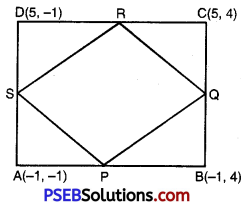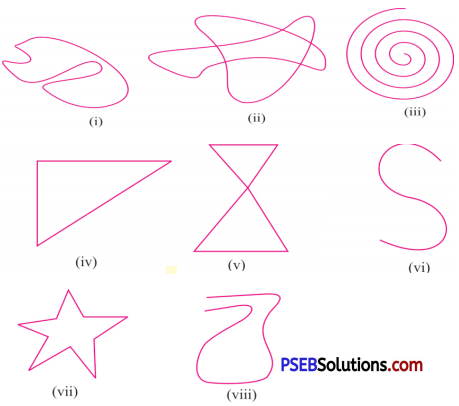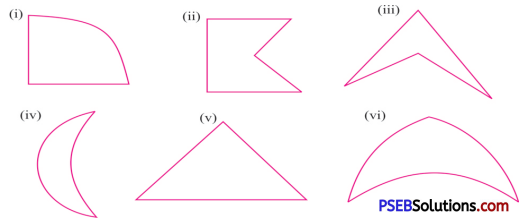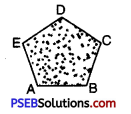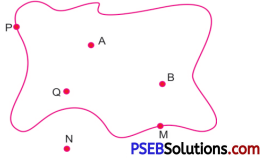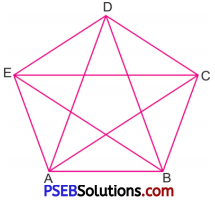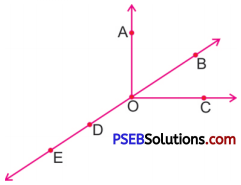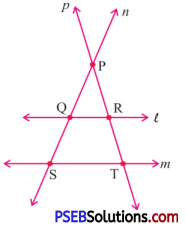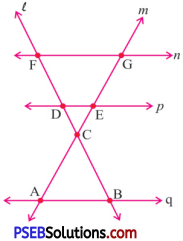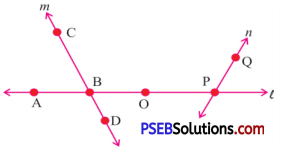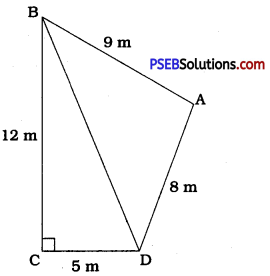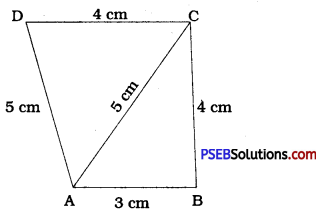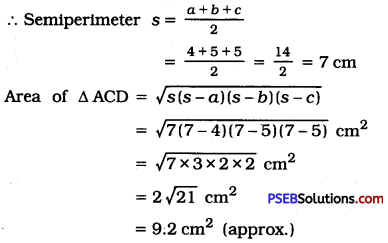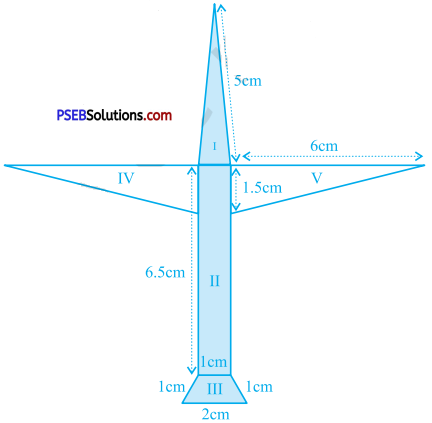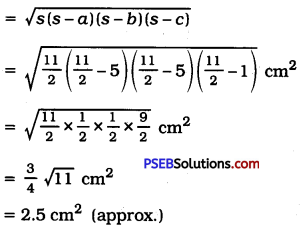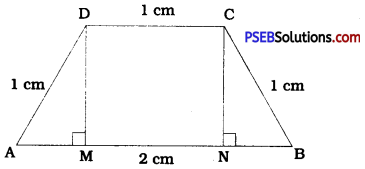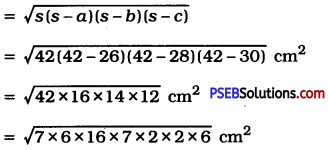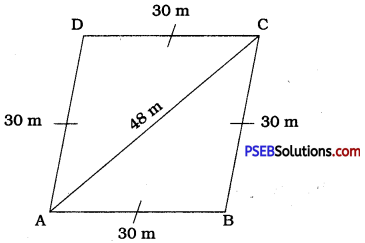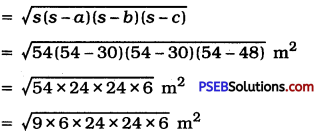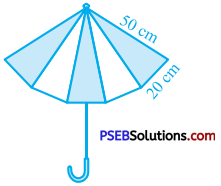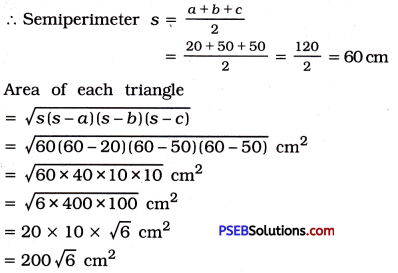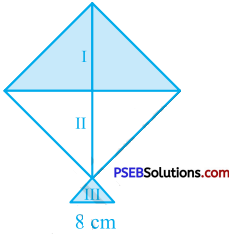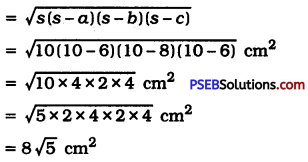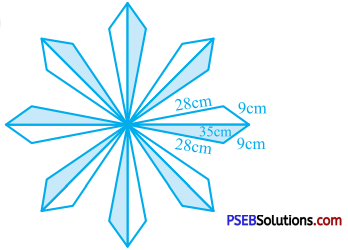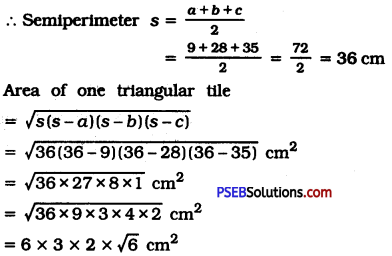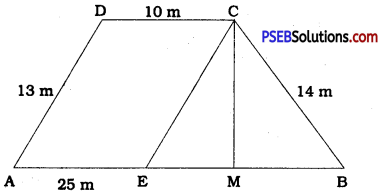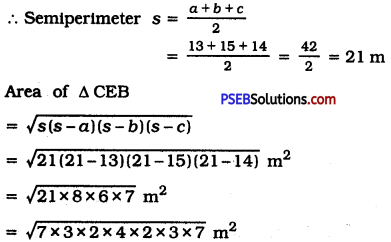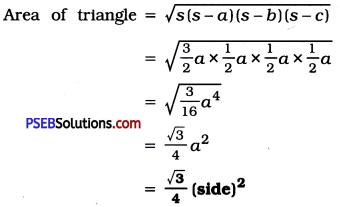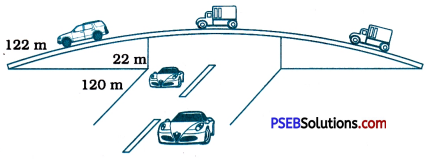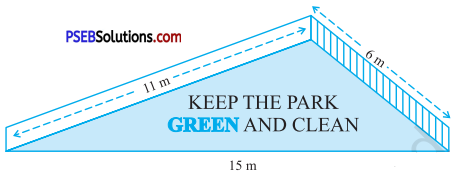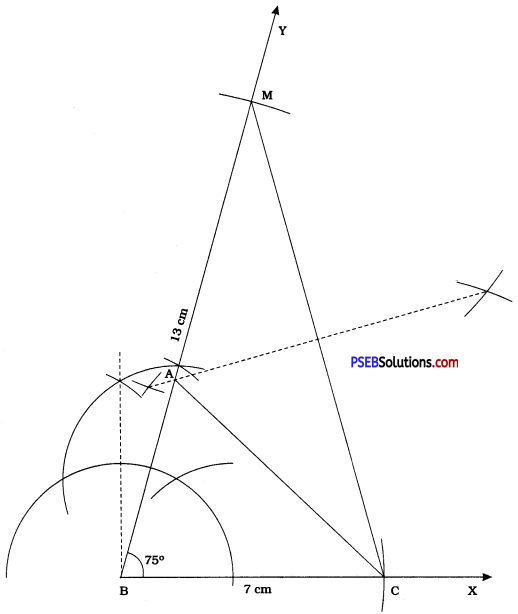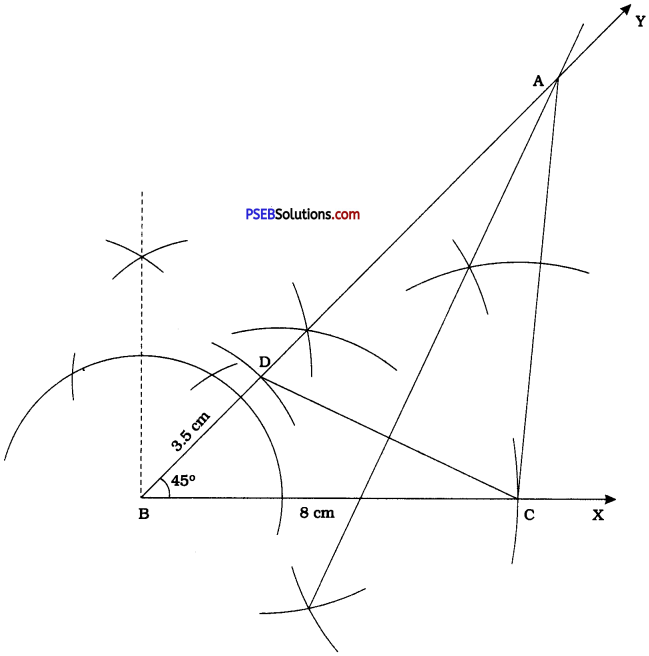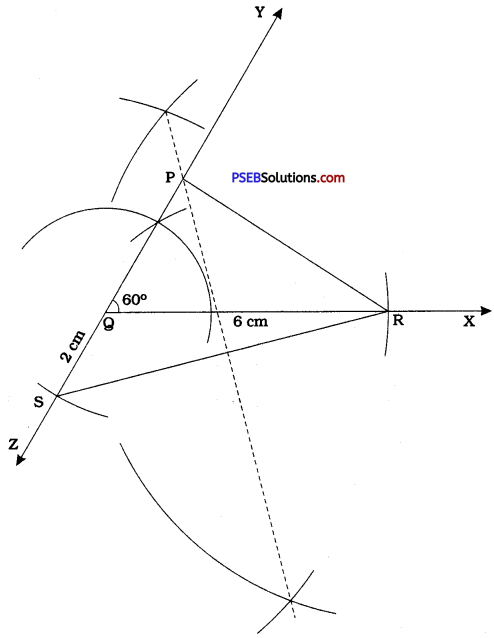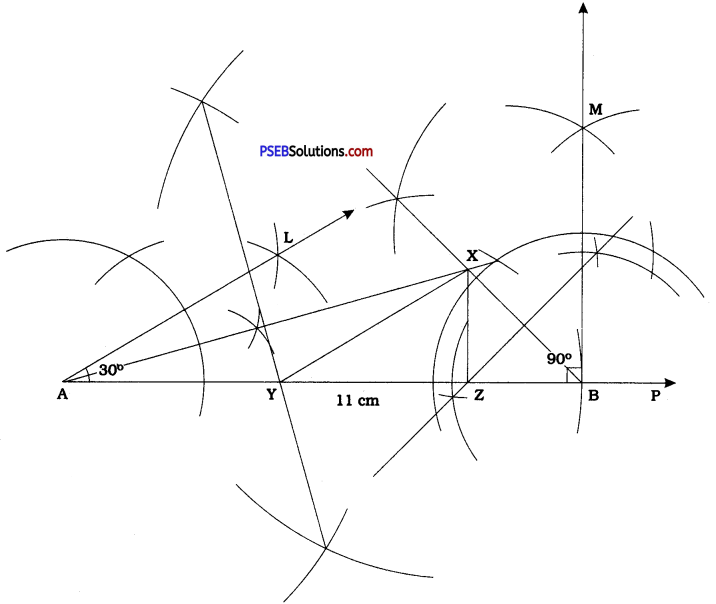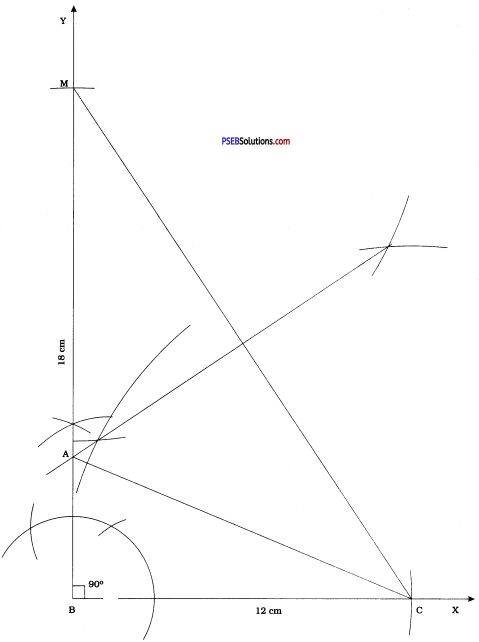Punjab State Board PSEB 12th Class Hindi Book Solutions हिन्दी साहित्य का इतिहास आधुनिक काल Questions and Answers, Notes.
PSEB 12th Class हिन्दी साहित्य का इतिहास आधुनिक काल
प्रश्न 1.
आधुनिक काल की परिस्थितियों पर संक्षेप में प्रकाश डालिए।
उत्तर:
आधुनिक काल के लगभग दो सौ वर्षों में हिन्दी-साहित्य समय के साथ-साथ बदलता रहा। इसी प्रकार परिस्थितियाँ भी बदलती रहीं। स्वतन्त्रता प्राप्ति से पूर्व की और स्वतन्त्रता प्राप्ति के बाद की परिस्थितियों में काफ़ी बड़ा अन्तर देखने को मिलता है। समूचे काल की परिस्थितियाँ निम्नलिखित हैं-
1. राजनीतिक परिस्थितियाँ भारत में व्यापार के लिए आई ईस्ट इण्डिया कम्पनी ने धीरे-धीरे यहाँ का शासन अपने हाथों में ले लिया। सन् 1857 की जन क्रान्ति की असफलता से कम्पनी शासन, विक्टोरिया शासन में बदल गया और मुग़ल साम्राज्य का अन्त हो गया। सन् 1885 में इण्डियन नैशनल कांग्रेस की स्थापना हुई। सन् 1905 में बंगाल का विभाजन हुआ। अंग्रेजी शासन के विरुद्ध जनता का आक्रोश बढ़ने लगा। अप्रैल 1919 में जलियांवाले बाग़ के नरसंहार के बाद इस आक्रोश की आग में घी डालने का काम किया। लाला लाजपतराय की हत्या और सरदार भगत सिंह और उसके साथियों को फाँसी दिए जाने की घटनाओं ने स्वतन्त्रता प्राप्ति की भावना को और तेज़ कर दिया। अंग्रेजों ने फूट डालो और राज करो की नीति के अन्तर्गत हिन्दू-मुसलमानों को आपस में लड़वाने का काम किया। अंग्रेज़ों ने देश को जातियों में बाँटकर अपना स्वार्थ सिद्ध किया। महात्मा गाँधी के अहिंसावाद, क्रान्तिकारी सुभाष बाबू (नेता जी) और शहीदों के बलिदान के फलस्वरूप भारत को 15 अगस्त, 1947 में स्वतन्त्रता प्राप्त हुई किन्तु देश का एक बड़ा भाग पाकिस्तान के रूप में देश से काट दिया गया।
स्वतन्त्रता प्राप्ति के बाद सन् 1962 में चीन से तथा सन् 1965 और सन् 1971 में पाकिस्तान के साथ युद्ध लड़ने पड़े। भारत की राजनीति में पिछले बीस-पच्चीस वर्षों में अनेक बदलाव हुए। देश से एक पार्टी का राज समाप्त हो गया जिसका स्थान गठबन्धन सरकारों ने ले लिया। राजनीति के अपराधीकरण की समस्या भी खड़ी हुई जिसका दुष्परिणाम आम लोगों को भोगना पड़ रहा है। राजनीति में भ्रष्टाचार ने अपनी गहरी पैठ बना ली है। शायद कोई नेता, कोई राजनीतिक दल देश को इन समस्याओं से उबार सके।
2. सामाजिक परिस्थितियाँ- आधुनिक काल के आरम्भ में देश में अंग्रेज़ी शासन स्थापित हो जाने के कारण सामाजिक ढांचे में भारी फेर बदल हुआ। अंग्रेज़ी शासन ने गाँवों की स्वतन्त्र इकाई को समाप्त कर दिया। इसके परिणामस्वरूप देश में बेरोज़गारी बढ़ गई। भारतीय समाज में जातिवाद, धार्मिक पाखंड तथा अन्धविश्वास बढ़ने लगे। अंग्रेजी शासन के परिणामस्वरूप ईसाई धर्म का प्रचार ज़ोरों से होने लगा परिणामस्वरूप आर्य समाज, ब्रह्म समाज, महाराष्ट्र समाज आदि अनेक सुधारवादी संगठन सक्रिय हो उठे। इन सुधारवादी संगठनों ने बाल-विवाह, सती-प्रथा एवं दहेज-प्रथा का डट कर विरोध किया और विधवा-विवाह का समर्थन किया।
स्वतन्त्रता प्राप्ति के पश्चात् भारतीय समाज में अनेक परिवर्तन हुए। देश का औद्योगीकरण हुआ जिससे रोजगार के साधन बढ़े, शिक्षा का प्रसार हुआ, नारी को समान अधिकार दिए गए। किन्तु खेद का विषय है कि देश में बेरोजगारी, बाल-विवाह और दहेज प्रथा जैसी समस्याएँ आज तक भी सुलझ नहीं पाई हैं।

3. धार्मिक परिस्थितियाँ- इस युग में सुधार आन्दोलनों एवं पाश्चात्य शिक्षा के प्रभाव और प्रचार से लोगों की चिन्तन पद्धति में अन्तर आने लगा। मार्क्सवाद की अवधारणा एवं रूस की क्रान्ति ने भी भारतीय जनमानस को आन्दोलित किया। पढ़े-लिखे वर्ग पर विवेकानन्द, टैगोर और श्री अरविन्द का यथेष्ट प्रभाव पड़ा।
स्वाधीनता आन्दोलन में समाज के सभी वर्गों का सहयोग अपेक्षित था इसलिए पिछड़े वर्गों के उद्धार की बात सामने आई। महात्मा गांधी ने जो हरिजन उद्धार का संकल्प लिया था उसे पूरा करने के लिए स्वतन्त्रता प्राप्ति के पश्चात् आने वाली सरकारों ने अनेक कानून बनाए। हिन्दू कोड बिल जैसे कानून बनाए गए और अक्तूबर, सन् 2007 में उच्चतम न्यायालय ने सभी धर्मों के लिए विवाह का पंजीकरण अनिवार्य बना दिया।
4. आर्थिक परिस्थितियाँ- इंग्लैण्ड के औद्योगिक विकास का प्रभाव भारत की अर्थव्यवस्था पर पड़ना स्वाभाविक था। इंग्लैण्ड के लिए भारत कच्चे माल का सस्ता स्रोत और तैयार माल की बड़ी मण्डी से अधिक महत्त्व नहीं रखता था। भारतीय कुटीर उद्योग इंग्लैण्ड के कारखानों में बने माल का मुकाबला न कर सके। भारत के लघु उद्योग धन्धे नष्ट हुए और कारीगर बेकार होकर काम धन्धों की तलाश में शहरों की ओर भागने लगे। शहरों में जनसंख्या बढ़ी और अशान्ति भी। अंग्रेजों ने अपने आर्थिक हितों की रक्षा के लिए रेल, डाक, तार का प्रचलन शुरू किया। इस काल में दोदो महायुद्ध हुए जिसके विनाश को झेलने के लिए अंग्रेज़ी शासन ने भारतीय जनता पर अनेक टैक्स लगा दिए। इससे मज़दूर और किसान अधिक प्रभावित हुए। अमीर और ग़रीब के बीच की खाई और अधिक बढ़ने लगी। स्वतन्त्रता प्राप्ति के पश्चात् देश का औद्योगीकरण किया गया। विकास के लिए पंचवर्षीय योजनाएँ बनाई गईं। किन्तु खेद का विषय है कि आम आदमी की आर्थिक हालत दिन-ब-दिन बिगड़ती जा रही है। सरकार की ओर से खर्च किया जा रहा करोड़ों अरबों रुपया आम आदमी तक भ्रष्टाचार के अजगर के मुँह में जा रहा है।
प्रश्न 2.
आधुनिक काल के साहित्य के विभाजन पर प्रकाश डालिए।
उत्तर:
आधुनिक काल का समय सन् 1843 से आज तक माना जाता है। इस काल में राजनीतिक, सामाजिक, आर्थिक स्थितियाँ इतनी तेजी से बदली कि विद्वानों ने अध्ययन की सुविधा के लिए तथा इसमें समय-समय पर होने वाले परिवर्तनों को पहचानने के लिए इस काल के साहित्य को अन्तर्युगों में विभाजित करने का प्रयास किया है। इन अन्तयुगों (उप-विभागों) के अनेक आधार हैं। कहीं प्रमुख साहित्यकार के नाम के आधार पर, कहीं इस काल की प्रवृत्ति पर इस अन्तर्युग का नामकरण किया गया। आचार्य रामचन्द्र शुक्ल आधुनिक काल को तीन युगों में बाँटते हैं-
भारतेन्दु युग-सन् 1868 से 1893 तक
द्विवेदी युग-सन् 1893 से 1918 तक
छायावादी युग-सन् 1918 से आज तक
वास्तव में जब शुक्ल जी ने हिन्दी साहित्य का पहला ग्रन्थ लिखा तब प्रगतिवाद, प्रयोगवाद, नई कविता का उदय नहीं हुआ था। शायद इसी कारणं कुछ विद्वानों ने इस काल को प्रथम उत्थान, द्वितीय उत्थान, तृतीय उत्थान एवं चतुर्थ उत्थान की संज्ञा दी है। डॉ० नगेन्द्र और डॉ० बच्चन सिंह का अन्तर्युग विभाजन निम्नलिखित है-
पुनर्जागरण काल-सन् 1857 से 1900 ई० तक
पूर्व स्वच्छन्दतावाद काल-सन् 1900 से 1920 ई० तक
स्वच्छन्दतावाद काल-सन् 1920 से 1940 ई० तक
उत्तर स्वच्छन्दतावाद काल-सन् 1940 से आज तक
उपर्युक्त काल विभाजन भी सही नहीं लगता क्योंकि 1940 और आज तक हिन्दी साहित्य ने कई रूप बदले हैं। अधिकतर विद्वान् निम्नलिखित काल विभाजन से सहमत हैं-
भारतेन्दु युग – सन् 1843 से 1893 तक
द्विवेदी युग – सन् 1893 से 1918 तक
छायावाद युग – सन् 1918 से 1935 तक
प्रगतिवाद युग – सन् 1935 से 1945 तक
प्रयोगवाद युग – सन् 1945 से 1955 तक
नयी कविता – सन् 1950 से 1980 तक
साठोत्तरी कविता – सन् 1969 से आज तक
पिछले बीस वर्षों में जनवादी कविता और अकविता आदि अनेक काव्य धाराएँ प्रचलित हुई हैं।
आधुनिक काल को हिन्दी गद्य काल भी कहा जाता है। इसी काल में उपन्यास, कहानी, नाटक, एकांकी के अतिरिक्त नव्यतर विधाएँ रेखाचित्र, संस्मरण, आत्मकथा, जीवनी, यात्रा वृत्त, रिपोर्ताज आदि का भी विकास हुआ है और हो रहा है।
प्रश्न 3.
आधुनिक काल की प्रमुख विशेषताओं का वर्णन कीजिए।
उत्तर:
(i) इंग्लैण्ड के औद्योगिक विकास का प्रभाव भारत की अर्थ-व्यवस्था पर पड़ना स्वाभाविक था। इंग्लैण्ड के लिए भारत कच्चे माल का सस्ता स्रोत और तैयार माल की बड़ी मण्डी से ज्यादा महत्त्व नहीं रखता था। भारतीय कुटीर उद्योग इंग्लैण्ड के कारखानों में बने माल का मुकाबला नहीं कर सके। भारतीय लघु उद्योग-धन्धे नष्ट हुए, कारीगर बेकार हो कर काम-धन्धों की तलाश में शहरों की ओर भागने लगे। शहरों में जनसंख्या बढ़ी और अशान्ति भी।
रेल, डाक, तार आदि का प्रचलन मूलतः अंग्रेजों के आर्थिक हितों की रक्षा के लिए हुआ था। परन्तु कालान्तर में इनसे राष्ट्रीयता की भावना तीव्र हुई। प्रथम महायुद्ध के पश्चात् अंग्रेजों द्वारा किए जा रहे आर्थिक शोषण का विरोध आरम्भ हुआ। कारखानों में व्यापक हड़तालें हुईं। सन् 1905 में बंग-भंग हुआ और इसके विरोध में स्वदेशी आन्दोलन की शुरुआत हुई। गांधी का चर्खा आन्दोलन और खादी का प्रचार इसी आर्थिक शोषण के विरोध का एक रूप था। आधुनिक कालीन साहित्य पर इसका सीधा प्रभाव पड़ा था।
इसकी दो प्रमुख विशेषताएं निम्नलिखित हैं-
I. देशभक्ति-आधुनिक काल में अंग्रेजों की नीतियों की प्रतिक्रिया में स्वदेशी आन्दोलन का जन्म हुआ। अकालों तथा आर्थिक शोषण के कारण देश की अत्यन्त दुर्दशा हो गई थी-
अंग्रेज़ राज सुख साज सजे सब भारी।
पै धन विदेस चलि जात इहै अति खारी॥
विदेशी वस्तुओं के परित्याग में विदेशी भाषा, विदेशी व्यवहार, विदेशी शिष्टाचार और पहनावा आदि सम्मिलित करके देशवासियों ने स्वदेशी भाषा, शिष्टाचार, पहनावा, खान-पान और स्वदेश प्रेम को अपनाने का प्रचार किया। प्रताप नारायण मिश्र के अनुसार-
चाहहु जु साँचों निज कल्याण। तो सब मिलि भारत सन्तान।
जपो निरन्तर एक ध्यान। हिन्दी, हिन्दू, हिन्दुस्तान॥
देश के पतन से पीडित हो कर इन्होंने अतीत का गौरव गान करने की चेष्टा की। इनकी देश भक्ति में किसी प्रकार की चाटुकारिता नहीं है। देश की जागृति के लिए इन्होंने ईश्वर से बारम्बार प्रार्थना की और जन जागृति के लिए जनता को सावधान किया-
सर्वस लिए जात अंग्रेज़, हम केवल लेक्चर के तेज़।
इस समय तक राष्ट्रीयता का स्वरूप बहुत व्यापक नहीं था इसलिए इन कवियों पर कुछ आलोचकों ने साम्प्रदायिकता का दोष लगाया है पर वास्तव में इन कवियों की जातीयता और पुनरुत्थानवाद की भावना को सन्देह की दृष्टि से नहीं देखा जाना चाहिए।
II. सुधारवादी दृष्टिकोण-आधुनिक युगीन कविता में देश प्रेम तथा समाज सुधार के लिए नवीन विषयों को ग्रहण किया गया। पश्चिमी भावों तथा विचारों ने इन कवियों को प्रभावित किया जिसके परिणामस्वरूप इनका प्रकृति की भौतिक शक्तियों पर विश्वास बढ़ा। हमारे देश में बाह्यचारों और साधनों ने धर्म और समाज को प्रभावित किया हुआ था। छुआछूत, पाखण्ड तथा रूढ़िवादी विचारों ने समाज को जकड़ रखा था। पश्चिमी सभ्यता के संपर्क में नया ज्ञान, आदर्श और नए सन्देह हमारे देश में आने लगे। यह युग भाषा, भाव और छन्द की दृष्टि से सामंजस्य का युग था। इन्होंने भक्त कवियों के समान सुधारवादी दृष्टिकोण अपनाये रखा तथा सूक्ति उपदेश पद्धति में काव्य सृष्टि की।
III. भक्ति भावना-भक्ति भारतीय समाज का अटूट हिस्सा है। आधुनिक काल में भक्ति-भावना का आधार विभिन्न समस्याओं को दूर करने के लिए ही साहित्यकारों के द्वारा स्वीकार नहीं किया गया अपितु मानसिक सबलता और आत्मिक सुख के लिए इसे आधार बनाया गया। भारतेन्दु ने स्वयं को राधा-कृष्ण का भक्त स्वीकार करते हुए कहा था-
मेरे तो साधन एक ही हैं
जय नंद लला, वृषभानु कुमारी॥
विभिन्न साहित्यकारों ने अपनी-अपनी श्रद्धा-भक्ति भावना से राम, कृष्ण, दुर्गा, शिव आदि देवी-देवताओं के प्रति अपने भावों को व्यक्त किया।
IV. प्रकृति-चित्रण-आधुनिक काल के साहित्यकारों ने प्रकृति का चित्रण चाहे अनेक पद्धतियों पर आधारित किया लेकिन उसका स्वतंत्र रूप से चित्रण किया। उन्होंने प्रकृति को निकट से देखा और उसका सुंदर लुभावना स्वरूप प्रस्तुत किया। उन्होंने प्रकृति के माध्यम से उपदेशात्मकता को भी महत्त्व दिया।-
पल-पल अंश घट घटे रजनी के, बढ़े दिवस का मान।
यथा अविद्या सकुचे ज्यों-ज्यों, त्यों त्यों विकसे ज्ञान।
V. भाषा सुधार-आधुनिक काल में भाषा संबंधी अनेक प्रकार के सुधार किए गए। द्विवेदी युग को तो कविता की भाषा से संबंधित ‘सुधार-युग’ भी कहा गया है। इस काल की कविता में ब्रज भाषा के स्थान पर खड़ी बोली को स्थापित किया गया। उसे व्याकरण के नियमों के अनुसार ढाला गया और वाक्य विन्यास में सुधार किए गए। इसका परिणाम यह हुआ कि खड़ी बोली का प्रयोग बढ़ा और उसकी शुद्धता में निखार आया।
VI. मानवतावाद और सांस्कृतिक जागरण-आधुनिक काल मानवता, उदारता और सांस्कृतिक जागरण का काल है। इस में भावनाओं को महत्त्व दिया गया और विश्व बंधुत्व की महत्ता को बल प्रदान किया गया। इससे मानव की आत्मा परिष्कृत हुई।
औरों को हँसते देखो मनु
हँसो और सुख पाओ।
अपने सुख को विस्तृत कर लो,
सबको सुखी बनाओ।
प्रगतिवादी साहित्य में दीन-हीन वर्ग का पक्ष लिया गया। उसमें अमीरों की अपेक्षा गरीबों-मजदूरों को अधिक महत्त्व दिया गया। इसमें संसार के किसी भी कोने में होने वाले अत्याचार का विरोध किया गया। साहित्यकारों ने ईश्वर पूजा की अपेक्षा असहाय मानव को अधिक महत्त्व दिया।
वास्तव में आधुनिक काल के साहित्य में मानवीय मूल्यों की अनूठे ढंग से स्थापना की गई है। पुराने मूल्यों को आधुनिक जीवन मूल्यों में स्थान प्रदान कर जीवनोपयोगी आधार को विस्तार प्रदान किया गया।
भारतेन्दु युग (सन् 1843-1893 तक)
प्रश्न 1.
भारतेन्दु युगीन काव्य की प्रमुख प्रवृत्तियों पर प्रकाश डालिए।
उत्तर:
भारतेन्दु युग के काव्य की प्रमुख प्रवृत्तियों का विश्लेषण करते हुए हम देखते हैं कि यह युग हिन्दी-साहित्य नव-निर्माण के लिए संक्रान्ति काल है। इस काल में एक ओर पुरानी परम्पराएँ और मान्यताएँ धीरे-धीरे साहित्य क्षेत्र से विदा ले रही थी तो दूसरी ओर नवीन प्रवृत्तियाँ प्रस्फुटित हो रही थीं। इस प्रकार हम भारतेन्दु युग को नवीनता और प्राचीनता के समन्वय का काल कह सकते हैं। इस युग के काव्य की प्रमुख प्रवृत्तियाँ निम्नलिखित हैं-
1. राजभक्ति और देश भक्ति-अंग्रेज़ी राज्य स्थापित होने के कारण रीतिकालीन कवियों की तरह अपने राजाओं की प्रशंसा करने की प्रवृत्ति इस युग में भी पाई जाती है, जिसे हम राज भक्ति कह सकते हैं। भारतेन्दु और प्रेमघन ने राजभक्ति सम्बन्धी कविताएँ लिखीं, किन्तु भारतेन्दु जी ने देश भक्ति को जागृत करने वाली कविताएँ भी लिखीं और अंग्रेज़ी राज्य की आलोचना की।
2. हिन्दू-मुस्लिम एकता का प्रचार-सन् 1857 के स्वतन्त्रता आन्दोलन में हिन्दू-मुसलमानों ने कन्धे से कन्धा मिला कर भाग लिया था। अंग्रेजों ने इन दोनों में फूट डालने का प्रयास किया जिसे भारतेन्दु युग के कवि सहन न कर पाये। उन्होंने अपनी रचनाओं में इस सामयिक स्थिति का मुकाबला करने के लिए हिन्दू-मुस्लिम एकता के गीत गाए।
3. सामाजिक कुप्रथाओं का विरोध-भारतेन्दु युग में आर्य समाज, सनातन धर्म, ब्रह्म समाज और महाराष्ट्र समाज ने जो समाज सुधार का आन्दोलन चलाया था उसका प्रभाव भारतेन्दु युग के कवियों पर भी पड़ा। उन्होंने बाल-विवाह, वृद्ध विवाह जैसी कुप्रथाओं के विरुद्ध अपनी कविता द्वारा आवाज़ उठाई।
4. मातृभाषा का उद्धार-भारतेन्दु युग के कवियों ने मातृभाषा हिन्दी के गौरव को पुनः स्थापित करने का प्रयास किया। भारतेन्दु जी ने तो यहाँ तक कह दिया कि ‘निज भाषा अन्नति अहै, सब उन्नति को मूल’। इस युग के कवियों ने हिन्दी भाषा के प्रति अनुराग उत्पन्न कर मातृभाषा का उद्धार किया।
5. भक्ति-भावना-भारतेन्दु युग में भक्ति भावना का प्रवाह देखने को मिलता है। स्वयं भारतेन्दु जी पुष्टि मार्ग में दीक्षित थे। इसके काव्य में विनय तथा मधुर भावना के दर्शन होते हैं। भक्ति के क्षेत्र में इस युग के कवियों ने श्रीकृष्ण को अपनी भक्ति के लिए चुना और उन्हें देश की जनता को जगाने का आह्वान किया।
6. श्रृंगार वर्णन-भारतेन्दु युग के कवियों ने रीतिकालीन कवियों की ही तरह श्रृंगार रस की भी कविताएँ लिखीं। इन कविताओं में नायिकाओं का नख-शिख वर्णन भी किया गया। किन्तु भारतेन्दु युगीन काव्य रीतिकाल जैसी अश्लीलता से युक्त था। इस श्रृंगार वर्णन में अधिकतर अशरीरी प्रेम को ही व्यक्त किया गया।
7. हास-परिहास व्यंग्य-भारतेन्दु युगीन काव्य में हास-परिहास और व्यंग्य भी काफ़ी मात्रा में देखने को मिलता है। भारतेन्दु जी की बन्दर सभा, उर्दू का स्यापा और खिताब कविताएँ इस प्रसंग में देखी जा सकती हैं।
द्विवेदी युग (सन् 1893-1918 तक)
प्रश्न 1.
द्विवेदी युगीन काव्य की प्रमुख प्रवृत्तियों पर प्रकाश डालिए।
उत्तर:
द्विवेदी युग में हिन्दी कविता ने एक नई करवट ली। बाल सुलभ चंचलता का स्थान अनुशासन, गाम्भीर्य और तत्व चिंतन ने ले लिया। इस युग की कविता उपदेशात्मकता अधिक होने के इतिवृत्तात्मक बन कर रह गई। इस युग की प्रमुख प्रवृत्तियाँ निम्नलिखित हैं-
1. खड़ी बोली की प्रतिष्ठा-द्विवेदी युग की कविता की सब से बड़ी विशेषता उसका खड़ी बोली में रचा जाना है। ब्रजभाषा के समर्थकों ने खड़ी बोली पर यह आरोप लगाया कि उसमें कोमल कांत पदावली और सुकुमारता का अभाव है और इसमें महाकाव्यों की रचना नहीं की जा सकती, किन्तु अयोध्यासिंह उपाध्याय ‘हरिऔध’ जी ने ‘प्रिय प्रवास’ और मैथिलीशरण गुप्त जी ने ‘साकेत’ लिखकर आलोचकों का मुँह बन्द कर दिया।
2. राष्ट्रीय भावना-द्विवेदी युग राष्ट्रीय जागरण का युग था। महात्मा गाँधी जी द्वारा चलाया जा रहा स्वतन्त्रता आन्दोलन जन-साधारण को प्रभावित कर रहा था। इसका प्रभाव हिन्दी कवियों पर भी पड़ा। मैथिलीशरण गुप्त, नाथू राम शर्मा शंकर, श्रीधर पाठक, माखन लाल चतुर्वेदी आदि कवियों ने राष्ट्रीय जागरण में पूरा-पूरा योगदान दिया।
3. धार्मिकता-उदात्त नैतिकता-द्विवेदी युग का काव्य विशद् धार्मिकता तथा उदात्त नैतिकता से व्याप्त है। इस युग के कवियों ने मानवतावाद को ग्रहण किया। उदारता और व्यापक मनोदृष्टि इस समय की धार्मिक कविता के विशेष लक्षण हैं।
4. समाज सुधार की भावना-रूढ़ियों का विरोध-द्विवेदी युग में आर्य समाज का सुधारवादी आन्दोलन अत्यन्त तीव्र और प्रखर हो गया था। ईस युग का काव्य भी इससे प्रभावित हुए बिना न रह सका। इस युग के काव्य में सामाजिक अन्याय और शोषण के विरुद्ध आवाज़ उठाई गई। शोषितों, किसानों, मजदूरों की दयनीय दशा का चित्रण किया गया। नारी शिक्षा का समर्थन किया गया। निराला जी की ‘विधवा’ और ‘भिक्षुक’ कविताएँ इसी युग में लिखी गईं।
5. नीति और आदर्श-द्विवेदी युगीन काव्य आदर्शवादी और नीतिपरक है। इतिहास और पुराण से लिए गए कथा प्रसंगों के आधार पर आदर्श चरित्रों पर अनेक प्रबन्ध काव्य लिखे गए। ‘हरिऔध’ जी का ‘प्रिय प्रवास’, गुप्त जी का ‘साकेत’ तथा ‘जयद्रथ वध’ तथा राम नरेश त्रिपाठी की ‘पथिक’ ऐसी ही आदर्शवादी रचनाएँ हैं।
6. प्रकृति चित्रण-प्रकृति चित्रण की दृष्टि से द्विवेदी युगीन काव्य अत्यन्त समृद्ध है। इस युग के अमेक कवियों ने प्रकृति सुषमा का अत्यन्त चारू भाषा में चित्रण किया है। श्रीधर पाठक की कविता ‘काश्मीर सुषमा’ के अतिरिक्त ‘प्रिय प्रवास’ और ‘साकेत’ और ‘पंचवटी’ जैसी रचनाओं में अनेक प्रकृति-चित्रणं देखने को मिलते हैं।
7. हास्य व्यंग्य-द्विवेदी युगीन कविता में भी हास्य व्यंग्य देखने को मिलता है किन्तु उसमें भारतेन्दु युग जैसा चुलबुलापन नहीं है। द्विवेदी जी के व्यक्तित्व के प्रभाव के कारण इस युग की कविता में हास्य-व्यंग्य संयत और मर्यादित है।

छायावाद युग (सन् 1918 से 1935 तक)
प्रश्न 1.
छायावाद युग की प्रमुख प्रवृत्तियों पर प्रकाश डालिए।
अथवा
छायावादी काव्य की विशेषताओं के बारे में लिखें।
उत्तर:
छायावाद के उदय के कई कारण हैं, इन कारणों के मूल में असंतोष की भावना ही प्रमुख थी। कुछ विद्वानों का मत है कि द्विवेदी युग की इतिवृत्तात्मकता ने ही इस काव्य चेतना को जन्म दिया। वास्तव में प्रकृति के माध्यम से अभिव्यक्त होने वाली काव्य चेतना ही छायावाद कहलाई। छायावादी कविता की निम्नलिखित प्रमुख विशेषताएँ हैं-
1. वैयक्तिता–छायावादी काव्य में वैयक्तिक सुख-दुःख की अभिव्यक्ति खुलकर हुई है। वस्तुतः छायावादी कवि विषय-वस्तु की खोज बाहर न करके अपने भीतर करता है परन्तु उसके निजीपन में भी संसार का दुःख समाया हुआ है। प्रसाद जी का ‘आँसू’ और पन्त जी के ‘अच्छवास’ और ‘आँसू’ व्यक्तिवादी अभिव्यक्ति के सुन्दर उदाहरण हैं।
2. प्रकृति-चित्रण-छायावादी कवियों ने प्रकृति को अपने काव्य में सजीव बना दिया है। डॉ० देवराज इसी कारण छायावादी काव्य को प्रकृति काव्य कहते हैं। छायावादी काव्य में प्रकृति सौन्दर्य के आलम्बन, उद्दीपन मानवीकरण, नारी रूप में अनेक चित्र मिलते हैं।
3. श्रृंगारिकता-छायावादी कवियों ने श्रृंगार भावना को प्रधानता दी है। किन्तु यह शृंगारिकता रीतिकालीन स्थूल एवं ऐन्द्रिय श्रृंगार से भिन्न है। छायावादी काव्य में शृंगारिकता दो रूपों में प्रकट हुई है-(1) नारी के सौंदर्य चित्रण द्वारा (2) प्रकृति पर नारी भावना के आरोप से। निराला जी की ‘जूही की कली’ प्रकृति के सौन्दर्य की उदात्तता का सुन्दर उदाहरण है।
4. वेदना और करुणा की भावना-छायावादी काव्य में वेदना निराशा से भरी नहीं है, उसमें सेवाभाव और मानवीयता का आभास होता है। छायावादी काव्य में वेदना का प्रवाह स्वाभाविक मनोभावों को लेकर है। इसलिए इस युग के कवियों का हृदय जनसाधारण के दुःख से दुःखी होकर चीत्कार कर उठता है।
5. जीवन के प्रति भावात्मक दृष्टिकोण-छायावादी कवियों को पलायनवादी कहा जाता है किन्तु उनके काव्य में पलायनवादी स्वर के साथ-साथ एक सुंदर समाज एवं संस्कृति की कल्पना भी निहित है। वह मानवता को नए हरेभरे परिधान में देखना चाहता है। विश्वमानवता उसका आदर्श है।
6. रहस्यानुभूति-कुछ आलोचक रहस्यवाद को छायावाद का प्राण मानते हैं किन्तु छायावादी काव्य जिज्ञासा मूलक रहस्य भावना है, उसे रहस्यवाद नहीं कहा जा सकता है। हां महादेवी का काव्य अवश्य रहस्यवादी कहा जा सकता है।
7. राष्ट्रीय भावना-छायावादी काव्य में राष्ट्रीय भावना के कुछ स्वर सुनाई पड़ते हैं। प्रसाद जी ने अपने नाटकों में कुछ ऐसे गीत लिखे हैं जिनमें राष्ट्रीय भावना की झलक देखने को मिलती है। प्रसाद जी के चन्द्रगुप्त नाटक में ‘अरुण यह मधुमय देश हमारा’ निराला जी की ‘जागो फिर एक बार’ तथा माखनलाल चतुर्वेदी जी की कविता ‘पुष्प की अभिलाषा’ इसके सुन्दर उदाहरण हैं।
प्रगतिवाद (सन् 1935-1945 तक)
प्रश्न 1.
प्रगतिवादी काव्य की प्रमुख प्रवृत्तियों पर प्रकाश डालिए। .
उत्तर:
प्रगतिवादी का आरम्भ हिन्दी-साहित्य में अप्रैल, सन् 1936 से मानना चाहिए; जब ‘अखिल भारतीय लेखक संघ’ का अधिवेशन मुंशी प्रेमचन्द की अध्यक्षता में हुआ। समाज में जागरण हुआ, जनता में चेतना आई, साम्यवाद की लहर उठी, मानव ने अपने अधिकारों को समझा और उसके लिए मांग की आवाज़ उठी। फलस्वरूप साहित्य में भी प्रगतिवाद का जन्म हुआ। प्रगतिवादी साहित्य कार्ल मार्क्स की विचारधारा से प्रभावित है। कुछ लोगों का मानना है कि मार्क्सवाद के प्रसार के लिए जो कविताएँ लिखी गईं उन्हें ही प्रगतिवाद का नाम दिया गया। प्रगतिवादी काव्य की प्रमुख प्रवृत्तियाँ निम्नलिखित हैं-
1. प्राचीन रूढ़ियों और संस्कृति का विरोध-प्रगतिवादी कवि प्राचीन रूढियों को समाज की प्रगति में बाधा मानता है, इसी कारण वह धर्म, ईश्वर अथवा परम्परागत संस्कृति का विध्वंस करना चाहता है। प्राचीन सांस्कृतिक आदर्शों में क्रान्ति लाना प्रगतिवादी काव्य का प्रधान स्वर है।
2. नास्तिकता-प्रगतिवादी कवि ईश्वर की सत्ता और धर्म में विश्वास नहीं रखते, उनका मत है कि मनुष्य अपने भाग्य का स्वयं निर्माता होता है, ईश्वर का उसमें कुछ हाथ नहीं। मार्क्स के अनुसार धर्म मनुष्य की विकासशील भावनाओं को नष्ट कर देता है। नवीन जी की ‘जूठे पत्ते’ में उनकी नास्तिकता प्रकट हुई है तथा सोहनलाल द्विवेदी स्वर्ग और नरक की धारणा को ही नकारते हैं।
3. शोषित वर्ग की दीनता का चित्रण-प्रगतिवादी कवियों ने शोषित वर्ग की दीनता के अनेक चित्र प्रस्तुत किये हैं। अधिकांश प्रगतिवादी काव्य मजदूरों और किसानों के पक्ष में लिखा गया है। भिक्षुओं से उन्हें सहानुभूति है। निराला जी की ‘भिक्षुक’ तथा ‘तोड़ती पत्थर’ कविताएँ उदाहरण स्वरूप ली जा सकती हैं।
4. शोषक वर्ग के प्रति घृणा-प्रगतिवादी कवि शोषक वर्ग से घृणा करता है। वह समझता है परिश्रम तो मज़दूर और किसान करते हैं और मज़ा लूटते हैं पूँजीपति। निराला जी ‘कुकुरमुत्ता’, नवीन जी की और भगवती चरण वर्मा की कविताएँ उदाहरणस्वरूप देखी जा सकती हैं।
5. क्रान्ति की भावना-प्रगतिवादी कवि वर्गहीन समाज की स्थापना करना चाहता है। ऐसा क्रान्ति के बिना सम्भव नहीं है। वह क्रान्ति का आह्वान करके जीर्ण-शीर्ण रूढ़ियों एवं परम्परा को जड़ से उखाड़ फेंकने में अपना गौरव समझता है। वह पूंजीपतियों के विनाश के लिए मज़दूरों को हिंसात्मक क्रान्ति के लिए उकसाता है। क्रान्ति के परिणाम का उल्लेख करता हुआ कवि कहता है-
अमीरों की है हवेली यहाँ। गरीबों की होगी पाठशाला वहाँ।
6. मार्क्सवाद में आस्था : रूस का गुणगान-प्रगतिवादी कवियों ने साम्यवाद के प्रवर्त्तक कार्ल मार्क्स तथा रूस का काफ़ी गुणगान किया है। ‘मार्क्स के प्रति’ शीर्षक कविता में पन्त जी ने कार्ल मार्क्स को प्रलयंकर शिव का तीसरा नेत्र बताया है। कवि की दृष्टि में साम्यवाद ही समाज और मनुष्यता का उद्धार करने वाला है। नरेन्द्र शर्मा सरीखे कई कवियों ने लाल रूस का गुणगान किया है।
7. नारी स्वतन्त्रता का पक्षपाती-प्रगतिवादी कवि नारी को स्वतन्त्र देखना चाहता है। वह समझता है कि मजदूर और किसान की तरह नारी भी युग-युगों से शोषण का शिकार है। इन कवियों ने नारी सौन्दर्य और कर्म को स्थापित करके उसकी मुक्ति के गीत गाए हैं।
प्रयोगवाद (सन् 1945 से 1955 तक)
प्रश्न 1.
प्रयोगवादी काव्यधारा की प्रमुख प्रवृत्तियों पर प्रकाश डालिए।
उत्तर-प्रयोगवाद का आरम्भ सन् 1943 में ‘अज्ञेय’ जी द्वारा सम्पादित ‘तारसप्तक’ नामक कविता संग्रह से माना जाता है। सन् 1951 में ‘दूसरा सप्तक’ प्रकाशित हुआ। इन दोनों काव्य संग्रहों में प्रयोगवाद का स्वरूप स्पष्ट नहीं हो पाया। अज्ञेय जी द्वारा सम्पादित ‘प्रतीक’, ‘पाटिल’ तथा ‘दृष्टिकोण’ पत्रिकाओं में भी प्रयोगवादी कविताएँ छपी। प्रयोगवादी कवियों का विश्वास है कि भाव और भाषा के क्षेत्र में नए प्रयोग होते रहने चाहिए। वे साहित्य में स्थिरता के पक्षपाती नहीं हैं। प्रयोगवादी कविता की प्रमुख प्रवृत्तियाँ निम्नलिखित हैं-
1. यथार्थ चित्रण-प्रयोगवादी कवि प्रगतिवादी कवियों की तरह फ्रॉयड और मार्क्स से प्रभावित लगता है। इसी कारण वह समाज का यथार्थ चित्रण अंकित करना चाहता है। भले ही वे चित्र अश्लील ही क्यों न बन जाएँ।
2. वर्ग भेद और वर्ग संघर्ष के चित्र- प्रयोगवादी कवि वर्ग संघर्ष के चित्र भी प्रस्तुत करता है। मुक्तिबोध की ‘लकड़ी का रावण’, धूमिल का ‘खेवली’, नागार्जुन की ‘प्रेत का बयान’, केदारनाथ अग्रवाल की ‘गुल मेंहदी’ कुछ ऐसी कविताएँ हैं।
3. व्यक्ति केन्द्रित कविता-प्रयोगवादी कविता मुख्यत: व्यक्ति केन्द्रित है। इसमें व्यक्ति की विशिष्टता, उसका अहम् और इकाई के रूप में व्यक्ति का महत्त्व अंकित हुआ है। प्रयोगवादी कवि समाज से कोई संबंध नहीं रखते। यह एक प्रकार से व्यक्तिवाद की चरम विकृति है।
4. मध्यवर्गीय व्यक्ति की कुंठा-प्रयोगवादी कवि क्योंकि मध्यम वर्ग से आए थे इसलिए उनके काव्य में मध्यमवर्गीय व्यक्ति की कुंठा, अनास्था को बड़ी ईमानदारी से उद्घाटित किया गया है। उनका दृष्टिकोण यथार्थवादी था और भावुकता के स्थान पर बौद्धिकता के प्रति उनका आग्रह अधिक था।
5. निराशा की प्रवृत्ति-प्रयोगवादी कवियों में पराजय बोध के कारण निराशा की प्रवृत्ति भी देखने को मिलती है। प्रयोगवादी कवि के लिए अतीत प्रेरणाहीन तथा भविष्य उल्लास एवं आकांक्षाओं से रहित है फलतः इस युग की कविता में दुःख और दुःख से उत्पन्न निराशा का चित्रण हुआ है।
6. बौद्धिकता की प्रचुरता-प्रयोगवादी कविता में बौद्धिकता आवश्यकता से भी अधिक है। प्रयोगवादी कवि पाठक के हृदय को नहीं मस्तिष्क को प्रभावित करना चाहता है। उसमें रागात्मकता के स्थान पर अस्पष्ट विचारात्मकता है। इसलिए उसमें साधारणीकरण की मात्रा का सर्वथा अभाव है।
भाषा का स्वरूप-प्रयोगवादी कवियों ने नए-नए उपमानों, प्रतीकों की सर्जना की है। प्रयोगवादी काव्य में बिम्बों का सफल प्रयोग हुआ है। प्रयोगवादी कवियों ने अन्तर्जगत की सूक्ष्म भावनाओं तथा कुंठाओं आदि को बिम्बों के द्वारा चित्रात्मक रूप प्रदान किया है।
नयी कविता (सन् 1950 से सन् 1980 तक)
प्रश्न 1.
नयी कविता काव्यधारा की प्रमुख प्रवृत्तियों पर प्रकाश डालिए।
उत्तर:
नयी कविता भारतीय स्वतन्त्रता के बाद लिखी गई उन कविताओं को कहा गया, जिनमें परम्परागत कविता से आगे नये मूल्यों और नये शिल्पविधान का अन्वेषण किया गया। सन् 1947 के बाद की हिन्दी कविता नवीन प्रयोगों के नाम पर असामाजिक, स्वार्थ प्रेरित, अहम्निष्ठ, घोर रुगण व्यक्तिवाद, दमित वासनाओं और कुंठाओं को बिना किसी उद्देश्य के कविता का रूप दिया जाने लगा। नयी कविता की प्रमुख प्रवृत्तियाँ निम्नलिखित हैं-
1. जीवन के प्रति आशा और विश्वास-नयी कविता के कवियों ने जीवन को जीवन के रूप में देखा है। नयी कविता में जीवन के प्रति आशा, विश्वास और आस्था के स्वर सुनाई पड़ते हैं।
2. मानवतावादी दृष्टिकोण-नयी कविता मानवतावादी आदर्श की परिकल्पनाओं पर आधारित नहीं है। वह यथार्थ की तीखी चेतना मनुष्य को उसके पूरे परिवेश को समझाने का बौद्धिक प्रयास करती है।
3. महानगरीय और ग्रामीण सभ्यता का यथार्थ चित्रण-नयी कविता में शहरी, महानगरीय तथा ग्रामीण जीवन संस्कारों के नवीन और यथार्थवादी चित्र देखने को मिलते हैं। अज्ञेय जी ‘साँप’ शीर्षक कविता तथा धूमिल की ‘खेवली’ शीर्षक कविता में क्रमश: शहरी और ग्रामीण जीवन के यथार्थ चित्र प्रस्तुत किये गए हैं।
4. जीवन मूल्यों का पुनः परीक्षण-नयी कविता जीवन मूल्यों की पुन: परीक्षा करती है। ये मूल्य जीवन की आवश्यकताओं के परिवेश में कितने खरे उतरते हैं और अपने रूढ़ रूप में कितने-कितने असंगतिपूर्ण हो गए हैं। इनका कितना स्वरूप आज के लिए ग्राह्य है आदि परीक्षण नयी कविता का कवि करता है।
5. व्यंग्य का स्वर-नयी कविता में व्यंग्य का स्वर अत्यन्त तीव्र हो उठा है। नयी कविता का कवि व्यावहारिक जीवन से अप्रस्तुत ग्रहण करता है और उसकी दृष्टि यथार्थ को विस्मरण नहीं कर पाती। अज्ञेय की कविता ‘साँप’, सक्सेना की कविता ‘गरीबी हटाओ’ में व्यंग्य का तीखा स्वर सुनाई पड़ता है।
6. प्रतीक योजना और बिंब विधान-नयी कविता के कवियों ने नूतनता के मोह में बड़े विचित्र प्रतीकों का प्रयोग किया है। जैसे बिछली घास, कलगी बाजरे की, घूरे पर उगा कुकुरमुत्ता, ज़िन्दगी मरा हुआ चूहा नहीं है, मुँह घर अजायब है आदि।

प्रमुख कवि
1. भारतेन्दु हरिश्चन्द्र (सन् 1850-1885 ई०)
प्रश्न 1.
भारतेन्दु हरिश्चन्द्र का संक्षिप्त जीवन परिचय देते हुए उनकी रचनाओं का उल्लेख कीजिए।
उत्तर:
जीवन-परिचय-भारतेन्दु जी का जन्म 4 सितम्बर, सन् 1850 को काशी में एक सम्पन्न वैश्य परिवार में हुआ। इनके पिता गोपालचन्द्र ब्रज भाषा के अच्छे कवि थे। जब ये पाँच वर्ष के थे तो इनकी माता का देहान्त हो गया, दस वर्ष के थे तो पिता का साया सिर से उठ गया। भारतेन्दु की आरम्भिक शिक्षा घर पर ही हुई। तेरह वर्ष की अवस्था में इनका विवाह हो गया। इनके दो पुत्र और पुत्री हुई। पुत्रों का बचपन में ही देहान्त हो गया। इनकी पुत्री विद्यावती का पुत्र हिन्दी साहित्य का प्रतिभावान् साहित्यकार व्रज रत्नदास हुआ।
भारतेन्दु जी ने सन् 1868 में कवि वचन सुधा’ नामक पत्रिका निकाली जिसमें पहले कविताएँ बाद में गद्य रचनाएँ प्रकाशित हुईं। सन् 1873 में आप ने ‘हरिश्चन्द्र मैगज़ीन’ नामक पत्रिका निकाली। भविष्य में इस पत्रिका का नाम ‘हरिश्चन्द्र चन्द्रिका’ हो गया। भारतेन्दु जी ने साहित्यिक संस्थाओं की स्थापना के साथ-साथ शिक्षा के प्रसार के लिए ‘चौखंभा स्कूल’ स्थापित किया। वही स्कूल आज ‘हरिश्चन्द्र डिग्री कॉलेज’ के नाम से प्रसिद्ध है।
सन् 1880 में ‘सार-सुधा-निधि’ पत्रिका में साहित्यकारों द्वारा हरिश्चन्द्र जी को भारतेन्दु की उपाधि से अलंकृत किये जाने का प्रस्ताव रखा। तब से आप भारतेन्दु नाम से विख्यात हो गए। 25 जनवरी, सन् 1885 को इनका देहान्त हो गया। भारतेन्दु का युग क्रान्ति और आन्दोलनों का युग था। समय की माँग को देखते हुए भारतेन्दु जी ने जनता को क्रान्ति के लिए तैयार करने तथा अंग्रेजी सरकार के अत्याचारों और दासता से मुक्त होने की चेतना जगाने के लिए साहित्य सृजन किया।
रचनाएँ-भारतेन्दु जी ने नाटक, कहानी, निबन्ध, इतिहास और काव्य बहुत कुछ और बड़ी मात्रा में लिखा। भारतेन्दु जी की काव्य कृतियों की संख्या 70 के करीब है जिनमें प्रमुख के नाम निम्नलिखित हैं-
- भक्ति सम्बन्धी-दान लीला, प्रेम तरंग, प्रेम प्रलाप, कृष्ण चरित्र आदि।
- श्रृंगार प्रधान-सतसई शृंगार, प्रेम माधुरी, होली, मधु मुकुल आदि।
- राष्ट्रीय कविताएँ- भारतवीरत्व, विजय की विजय-वैजन्ती, सुमनांजली आदि।
- हास्य व्यंग्य प्रधान-बन्दर-सभा, बकरी का विलाप, उर्दू का स्यापा आदि।
प्रश्न 2.
भारतेन्दु हरिश्चन्द्र के काव्य की प्रमुख विशेषताओं पर प्रकाश डालिए।
उत्तर:
भारतेन्दु जी के काव्य का क्षेत्र बहुत विस्तृत है एवं विविधता लिए हुए है। यहाँ केवल उनके काव्य की प्रमुख विशेषताओं का ही उल्लेख किया जा रहा है-
1. भक्ति भावना-भारतेन्दु जी सूरदास जी की तरह वल्लभ सम्प्रदाय के अनुयायी थे अतः उनकी भक्ति भावना पुष्टिमार्गी है। इनकी भक्ति प्रधान रचनाओं में विनय, बाल लीला, सख्य और दाम्पत्य प्रेम से सम्बन्धित सभी प्रकार के पद मिलते हैं। इन भक्ति सम्बन्धी पदों में शुद्ध गीत शैली के सभी तत्व पाये जाते हैं।
जनता में धार्मिक सद्भावना बनाये रखने के लिए भारतेन्दु जी ने हज़रत मुहम्मद साहब और हज़रत इमाम हुसैन की जीवनियाँ भी लिखीं।
2. श्रृंगार भावना-भक्त होने के साथ-साथ भारतेन्दु जी रसिक भी थे, फलतः रीतिकाल के अनुकरण पर कवित्त और सवैया छंद में शृंगारिक रचनाएँ की जो कवि की अनुभूति से भरपूर है। भारतेन्दु जी की अधिकांश कविताओं का मुख्य आधार राधा-कृष्ण प्रेम वर्णन है किन्तु उसमें रीतिकालीन कवियों की तरह कुत्सित मनोवृत्तियों का प्रकाशन न था।
3. राष्ट्रीयता एवं समाज-सुधार की भावना-भारतेन्दु जी का जन्म एक देशभक्त घराने में हुआ था। अतः देश भक्ति उनके खून में थी। अंग्रेज़ी शासन के कुप्रभावों का उन्होंने अपनी कविता में वर्णन किया है। उन्होंने देशवासियों को प्राचीन गौरव पुनः प्राप्त करने का संदेश दिया है तथा देश के जनमानस में राष्ट्रीय भावना जगाने के लिए प्राचीन रूढ़ियों एवं बुराइयों को त्यागने की सलाह दी। भारत वीरत्सव’ में उनकी देश प्रेम की भावना अधिक उजागर हुई है।
4. प्रकृति चित्रण-भारतेन्दु जी प्रकृति चित्रण के क्षेत्र में अधिक सफल नहीं रहे। उनके काव्य में प्रकृति के बाह्य रूप का वर्णन मात्र है। किन्तु उनका प्रकृति चित्रण अपने ढंग का था जो अपनी इतिवृत्तात्मकता के कारण आगे चलकर छायावादी युग का सबसे बड़ा वैभव बन गया।
5. हास्य-व्यंग्य-भारतेन्दु जी की कविता में हास्य व्यंग्य प्रचुर मात्रा में देखने को मिलता है। उन्होंने मुकरियों के माध्यम से बड़ा तीखा व्यंग्य किया है। ‘बन्दर सभा’ में निम्न कोटि के नाटकों का उपहास उड़ाया है तो ‘उर्दू का स्यापा’ शीर्षक कविता में उर्दू के पक्षपातियों पर व्यंग्य किया है।
2. मैथिलीशरण गुप्त (सन् 1886-1964 ई०)
प्रश्न 1.
श्री मैथिलीशरण गुप्त का संक्षिप्त जीवन परिचय देते हुए उनकी रचनाओं का उल्लेख कीजिए।
उत्तर:
मैथिलीशरण गुप्त जी का जन्म 3 अगस्त, सन् 1886 ई० को झाँसी जिला के चिरगाँव नामक स्थान में एक सम्पन्न वैश्य परिवार में हुआ। गुप्त जी का विद्यारम्भ गाँव की पाठशाला से हुआ। इसके बाद झाँसी के मैकडालनड हाई स्कूल में भेजे गये किन्तु वहाँ इनका पढ़ने में मन नहीं लगा वे चिरगाँव लौट आए। घर पर ही उन्होंने हिन्दी, संस्कृत, बंगला, उर्दू, मराठी और अंग्रेज़ी का अध्ययन किया। गुप्त जी का आरम्भिक जीवन बड़ा संघर्षमय रहा। सत्रह वर्ष के होते होते इनके पिता का तथा उन्नीस वर्ष के होने पर इनकी माता का देहान्त हो गया। गुप्त जी ने तीन विवाह किये। बच्चों की असमय मृत्यु हो गई। केवल एक बेटा उर्मिला चरण जीवित रहा, जो आजकल स्वतन्त्र रूप से लेखन कार्य कर रहा है।
गुप्त जी के काव्य को प्रतिष्ठा दिलाने में आचार्य महावीर प्रसाद द्विवेदी जी का बहुत बड़ा हाथ है। वे गुप्त जी की कविताओं में संशोधन कर ‘सरस्वती’ पत्रिका में प्रकाशित किया करते थे। साथ ही गुप्त जी को अच्छी कविता लिखने के लिए प्रेरित भी करते थे।
गुप्त जी महात्मा गाँधी और स्वतन्त्रता आंदोलन से बहुत प्रभावित हुए। स्वतन्त्रता आन्दोलन में भाग लेने पर दो बार इन्हें जेल भी जाना पड़ा। स्वतन्त्रता प्राप्ति के पश्चात् आप दो-बार राज्य सभा के सदस्य भी मनोनीत हुए (1952 से 1964 तक)। ‘साकेत’ महाकाव्य पर इन्हें मंगला प्रसाद पुरस्कार भी प्रदान किया गया। भारत सरकार ने भी इन्हें ‘पद्म भूषण’ की उपाधि से सम्मानित किया। सन् 1964 में गुप्त जी परलोक सिधार गए।
रचनाएँ-राष्ट्र कवि कहे जाने वाले मैथिलीशरण गुप्त जी ने करीब चालीस काव्य ग्रन्थों का सृजन किया। इनमें प्रमुख और लोकप्रिय काव्य ग्रन्थ निम्नलिखित हैं-
- जयद्रथ वध
- साकेत
- पंचवटी
- यशोधरा
- गुरुकुल
- रंग में भंग
- द्वापर
- भारत भारती।
प्रश्न 4.
मैथिलीशरण गुप्त के काव्य की विशेषताओं पर प्रकाश डालिए।
उत्तर:
गुप्त जी की रचनाओं का अवलोकन करने पर यह स्पष्ट हो जाता है कि वे मूलतः भारतीय संस्कृति के कवि हैं। गुप्त जी के काव्य की निम्नलिखित विशेषताएँ हैं-
1. प्राचीनता और आधुनिकता का समन्वय-युग की बदली हुई परिस्थितियों के अनुरूप गुप्त जी ने भारतीय संस्कृति को एक नया रूप प्रदान किया। उन्होंने प्राचीनता और आधुनिकता का अपूर्व समन्वय किया। रामायण, महाभारत, पुराण, इतिहास जो भारतीय संस्कृति के अभिन्न अंग हैं, गुप्त जी ने उनको युग के अनुसार आधुनिकता प्रदान की है।
2. भक्ति भावना-गुप्त जी में वैष्णव संस्कार कूट-कूट कर भरे हुए थे। गुप्त जी ने अपने प्रत्येक ग्रन्थ के मंगलाचरण में श्री राम की वन्दना की है। गुप्त जी का विश्वास है कि श्री राम आज भी आदर्श हो सकते हैं, उनका अनुकरण किया जा सकता है।
3. भारतीय संस्कृति की झलक-गुप्त जी के काव्य में भारतीय सभ्यता, आचार-विचार, रीति-नीति, दर्शनसाहित्य का वर्णन देखने को मिलता है। ‘स्वदेश प्रेम’, ‘किसान’, ‘वैतालिक’ आदि कविताओं में गुप्त जी भारतीय संस्कृति का आह्वान करते हैं। ‘जयद्रथ वध’ में भी उन्होंने गीता के ‘कर्म करो किन्तु फल की चिन्ता न करो’ सिद्धान्त का वर्णन किया है।
4. राष्ट्रीयता-गुप्त जी की प्रत्येक रचना राष्ट्रीय उत्थान के लिए है, इसी कारण उन्हें राष्ट्रकवि कहा जाता है। गुप्त जी की राष्ट्रीय भावना का एक उद्देश्य देश को स्वतन्त्र देखना और उसमें पुनः आत्म गौरव और शक्ति जगाना है। गुप्त जी ने इस उद्देश्य की पूर्ति के लिए अतीत के गौरव का गान किया, देश-भक्ति का पाठ पढ़ाया तथा अधिकारों के साथ कर्तव्यों पर भी ध्यान देने की बात कही।
5. उपेक्षित पात्रों का चरित्र-चित्रण-गुप्त जी ने इतिहास द्वारा उपेक्षित पात्रों को अपने काव्य में स्थान देकर उन पात्रों से किये गए अन्याय की ओर सब का ध्यान आकर्षित किया। उन्होंने ‘साकेत’ में उर्मिला, ‘यशोधरा’ में गौतम पत्नी यशोधरा, ‘विष्णुप्रिया’ में चैतन्य महाप्रभु पत्नी विष्णुप्रिया तथा ‘साकेत’ में कैकेयी के चरित्रों के प्रति समाज की सहानुभूति जागृत की।
6. प्रकृति चित्रण-गुप्त जी के काव्य में प्रकृति उनके काव्य की सहचरी बनकर आई है। प्रकृति कवि के साथ हँसी व रोयी है। गुप्त जी के काव्य ‘पंचवटी’ और ‘साकेत’ में प्रकृति की सुषमा बिखरी पड़ी है। ‘पंचवटी’ में प्रकृति के मनोरम रूप की झाँकी निम्नलिखित पंक्ति में देखी जा सकती है-
चारु चन्द्र की चंचल किरणें खेल रही हैं जल थल में।
3. जयशंकर प्रसाद (सन् 1889-1937 ई०).
प्रश्न 1.
श्री जयशंकर प्रसाद का संक्षिप्त जीवन परिचय देते हुए उनकी काव्य कृतियों का उल्लेख करें।
उत्तर:
प्रसाद जी का जन्म सन् 1889 को काशी के गोवर्धन सराए महल्ले में एक सम्पन्न वैश्य परिवार में हुआ। इनके पिता तम्बाकू का व्यापार करने के कारण ‘सुंघनी साहू’ के नाम से प्रसिद्ध थे। प्रसाद जी कक्षा सात तक ही स्कूल में पढ़े। इसके बाद घर पर ही इनकी शिक्षा दीक्षा का कार्य हुआ। अभी यह बारह वर्ष के ही थे कि इनके पिता का देहांत हो गया। अगले पाँच वर्षों में इनकी माता और बड़े भाई का भी देहांत हो गया। परिणामस्वरूप छोटी अवस्था में ही इन्हें पिता का व्यवसाय सम्भालना पड़ा। प्रसाद जी ने इन घोर दैवी आपदाओं के बीच भी अपना धैर्य बनाए रखा। परिवार की बिगड़ती दशा को सुधारने के लिए इन्होंने जी जान से कड़ा परिश्रम किया।
प्रसाद जी दुकानदारी का काम देखते हुए बचपन से ही समस्या पूर्ति तथा मुक्तक पद्य रचना किया करते थे। इनकी रचनाएँ ‘इन्दु’, ‘हंस’ और ‘जागरण’ मासिक पत्रिकाओं में प्रकाशित होती थीं।
प्रसाद जी ने तीन विवाह किए। तीसरे विवाह से इन्हें रत्नशंकर नामक पुत्र रत्न की प्राप्ति हुई किन्तु उनका हृदय सदैव सांसारिक मोह माया से विरक्त रह कर जीवन के शाश्वत मूल्यों की ओर ही उन्मुख रहा। पारिवारिक चिन्ताओं से प्रसाद जी जीवन पर्यन्त मुक्त नहीं हो पाए। जीवन के अन्तिम दिनों में आप तपेदिक से पीड़ित रहे। इसी रोग के कारण 15 नवम्बर, 1937 को इनकी मृत्यु हो गई।
रचनाएँ-प्रसाद जी ने पद्य और गद्य दोनों क्षेत्रों में अपनी कुशाग्र बुद्धि और प्रतिभा का परिचय दिया। उन्होंने कविता, नाटक, कहानी, उपन्यास और निबन्ध सभी विधाओं में साहित्य सर्जना की। उनकी प्रमुख काव्य कृतियों के नाम इस तरह हैं-
- चित्राधार
- प्रेमपथिक
- करुणालय
- महाराणा का महत्त्व
- कानन कुसुम
- झरना
- आँसू
- लहर
- कामायनी।
‘कामायनी’ पर इन्हें मरणोपरांत मंगलाप्रसाद पुरस्कार भी दिया गया। इनकी रचनाएँ ‘झरना’, ‘लहर’ और ‘आँसू’ . भी हिन्दी साहित्य में विशेष महत्त्व रखती हैं।

प्रश्न 2.
श्री जयशंकर प्रसाद के काव्य की विशेषताओं पर प्रकाश डालिए।
उत्तर:
प्रसाद जी ने हिन्दी साहित्य में छायावाद का द्वार खोला। प्रसाद जी की काव्य कृतियों के आधार पर उनके काव्य की प्रमुख विशेषताएँ निम्नलिखित हैं-
1. श्रृंगारिकता–प्रसाद जी मूलतः प्रेम और यौवन के कवि हैं। उनके काव्य में रागात्मकता की प्रधानता है। उनके काव्य में संयोग शृंगार की अपेक्षा वियोग शृंगार की अधिक प्रधानता है। ‘आँसू’ में वियोग शृंगार की और ‘कामायनी’ में संयोग शृंगार का वर्णन दर्शनीय है।
2. प्रेम भावना-‘प्रेम पथिक’ से लेकर वाद की रचनाओं में प्रसाद जी के काव्य में अनुभूति और विचरण का अद्भुत मिश्रण देखने को मिलता है। प्रेम की भावना अपने आप में अनन्त है और उसकी चरम परिणति त्याग वृत्ति में है। ‘प्रेम पथिक’ में प्रसाद जी तात्विक निष्कर्षों की स्थिति में पहुँच गए लगते हैं। इस प्रेम चित्रण में परम्परा के रक्षण की स्थिति कम और नवीनता का उद्योग अधिक दिखता है।
3. प्रकृति प्रेम-आरम्भ में प्रेम और यौवन के मादक कवि प्रसाद जी प्रकृति की ओर आकृष्ट हुए। प्रकृति के प्रति उनका तीव्र आकर्षण है। प्रकृति के मानवीकरण का सुन्दर उदाहरण उनकी ‘बीती विभावरी’ कविता है। प्रसाद जी के काव्य में प्रकृति के सुन्दर, ऐश्वर्यमयी और प्रेरक चित्र हैं वहाँ उसके महाविनाशकारी और भयंकर रूप भी देखने को मिलते हैं। ‘कामायनी’ में प्रकृति के इन दोनों रूपों को देखा जा सकता है।
4. रहस्योन्मुखता-प्रसाद जी के काव्य में रहस्यवाद की झलक भी देखने को मिलती है। वे उस अनन्त सत्ता के दर्शन के लिए लालायित दीखते हैं। वे तर्क और बुद्धि से नहीं अपितु ज्ञान और कल्पना के सहारे उस विश्वात्मा को पहचानना चाहते हैं प्रसाद जी की रहस्य भावना प्रकृति के माध्यम से भी मुखरित हुई है।
5. मानवीय भावनाएँ-प्रसाद जी मानवीय भावनाओं के कवि हैं। ‘कामायनी’ में मानवीय प्रकृति के मूल मनोभावों का सूक्ष्म रूप में चित्रण किया गया है। ‘कामायनी’ में श्रद्धा का तकली गीत इसका उदाहरण है। यहाँ प्रसाद जी गाँधीवाद से प्रभावित दीखते हैं। ‘कामायनी’ में प्रसाद जी ने भारत की चिर उपेक्षित नारी को-नारी तुम केवल श्रद्धा हो-कह कर आदर-सत्कार प्रदान किया है।
4. सूर्यकांत त्रिपाठी “निराला’ (सन् 1896-1961 ई०)
प्रश्न 1.
‘निराला’ जी का संक्षिप्त जीवन परिचय देते हुए उनकी काव्यकृतियों का उल्लेख कीजिए।
उत्तर:
जीवन-परिचय-सूर्यकांत त्रिपाठी ‘निराला’ का जन्म सन् 1896 ई० में बंगाल की महिषादल नामक रियासत में मेदनीपुर में बसंत पंचमी वाले दिन हुआ। इनका बचपन का नाम सूर्यकुमार था। सूर्यकुमार से ये सूर्यकांत हो गए। ‘मतवाला’ पत्रिका में काम करते समय इन्होंने उससे मेलखाता अपना उपनाम ‘निराला’ रख लिया। निराला जी की आरम्भिक शिक्षा बंगाल में ही हुई। कालान्तर में इन्होंने संस्कृत, उर्दू, अंग्रेजी भाषा तथा साहित्य का अच्छा ज्ञान प्राप्त किया।
निराला जी का जीवन संकटों से भरा रहा। तीन ही वर्ष के थे कि इनकी माता का देहान्त हो गया। तेरह वर्ष की अवस्था में इनका विवाह मनोहरा देवी से हो गया। सन् 1918 में मनोहरा देवी अपने पीछे एक पुत्र और एक पुत्री को छोड़कर स्वर्ग सिधार गईं। थोड़े ही दिनों के बाद इनके चाचा, पिता और अन्य कई रिश्तेदार भी इनफलूइंजा का शिकार होकर चल बसे। सन् 1935 में उनकी पुत्री सरोज भी संसार से विदा हुई। निराला पर सरोज की मृत्यु का गहरा आघात लगा। लगा जैसे वे टूट गए हों।
सन् 1920 में निराला ने महिषादल राज्य की नौकरी छोड़ दी। सन् 1922 में आचार्य महावीर प्रसाद द्विवेदी जी की प्रेरणा से इन्होंने कोलकाता से प्रकाशित होने वाली पत्रिका ‘समन्वय’ का संपादन भार संभाला। उसके बाद वे ‘मतवाला’ पत्रिका के संपादक मंडल में चले गए। इसी पत्रिका में इनकी प्रसिद्ध कविता ‘जूही की कली’ प्रकाशित हुई। सन् 1950 तक तो निराला जी जगह-जगह भटकते रहें। पर उन्होंने साहित्य-सृजन नहीं छोड़ा। सन् 1949 में इनकी काव्यकृति ‘अपरा’ पर उत्तर प्रदेश सरकार ने इन्हें 2100 रुपए का पुरस्कार प्रदान किया।
15 अक्तूबर, सन् 1961 में इलाहाबाद में इनका देहान्त हो गया। रचनाएँ-निराला जी ने कोई दर्जन भर काव्य-कृतियाँ हिन्दी साहित्य को दी जिनमें से प्रमुख के नाम निम्नलिखित
- अनामिका
- परिमल
- गीतिका
- तुलसीदास
- कुकुरमुत्ता
- अणिमा
- नए पत्ते
- बेला
- अर्चना।
प्रश्न 2.
‘निराला’ के काव्य की विशेषताओं पर प्रकाश डालिए। हैं-
उत्तर:
‘निराला’ जी के काव्य में जीवन की विविधता के दर्शन होते हैं। इनके काव्य की प्रमुख विशेषताएँ निम्नलिखित हैं-
1. छायावादी दृष्टिकोण-निराला जी छायावाद के प्रमुख चार स्तम्भों में एक माने जाते हैं। इनकी ‘जूही की कली’ कविता से ही छायावाद का आरम्भ माना जाता है। छायावादी काव्य में प्रकृति के माध्यम से श्रृंगार का वर्णन किया गया है। छायावादी काव्य में वैयक्तिता का चित्रण अधिक हुआ है। ‘जूही की कली’ और ‘विफल वासना’ शीर्षक कविताएँ क्रमश: इन्हीं भावों को व्यक्त करती हैं।
2. रहस्य भावना और दार्शनिकता-निराला जी की कविता में रहस्यवाद भी देखने को मिलता है। उनके अधिकांश पदों में भले ही मानव जीवन के चित्र देखने को मिलते हैं, किन्तु वे सबके सब रहस्यानुभूति से अनुरंजित हैं। आत्मा के परमात्मा के लिए अभिसार, मिलन और वियोग आदि की सजीव अभिव्यक्ति निराला जी के काव्य में देखने को मिलती है। उनकी रहस्यानुभूति में दार्शनिकता का गूढ चिन्तन भी है जैसे उनकी ‘तुम और मैं’ कविता।
3. प्रगतिवादी विचारधारा-निराला जी के हृदय में दुःखी मानव के लिए करुणा है। उनकी ‘भिक्षुक’, ‘विधवा’, ‘वह तोड़ती पत्थर’ तथा ‘दान’ इसी भाव को अभिव्यक्त करती हैं। निराला जी ने ‘कुकुरमुत्ता’ में शोषकों के प्रति व्यंग्य, आक्रोश और घृणा भी व्यक्त की है और शोषितों के प्रति सहानुभूति भी। निराला जी ने मानव-मानव में विषमता फैलाने वाली आसुरी प्रवृत्तियों और दूसरे देशों को गुलाम बना कर उनका दमन करने वाली शक्तियों के संहार के लिए शक्ति (देवी) का आह्वान करते हुए कहा है-‘एक बार बस और नाच तू श्यामा’।
4. राष्ट्रीयता की भावना-निराला जी की छायावादी कविताओं में राष्ट्रीयता की भावना भी देखने को मिलती है। उन्होंने राष्ट्रीय प्रभाती के रूप में उद्बोधन गीत भी लिखे हैं जिनमें छायावाद की पूरी कोमलता एवं चित्रमयता दृष्टिगोचर होती है। उदाहरणस्वरूप उनकी ‘जागो फिर एक बार’ कविता देखी जा सकती है। इसके अतिरिक्त ‘भारती जय विजय करें’, ‘मातृभूमि की वन्दना’, ‘महाराज शिवाजी का पत्र’, ‘राम की शक्ति पूजा’ और ‘तुलसीदास’ आदि कविताएँ भी इसी कोटि की हैं।
निष्कर्ष रूप में कहा जा सकता है कि निराला जी छायावादी काव्य प्रवृत्तियों के समर्थ कवि होने के साथ-साथ राष्ट्रीय चेतना एवं प्रगतिवादी स्वर के भी सक्षम उद्घोषक थे।
5. सुमित्रानन्दन पन्त (सन् 1900-1977 ई०)
प्रश्न 1.
पन्त जी का संक्षिप्त जीवन परिचय देते हुए उनकी काव्य कृतियों के नाम लिखिए।
उत्तर:
कविवर सुमित्रानन्दन पन्त जी का जन्म 21 मई, सन् 1900 ई० के दिन उत्तर प्रदेश के (आजकल उत्तराखण्ड) अलमोड़ा जिले के कौसानी गाँव में हुआ। पैदा होते ही इनकी माता का देहान्त हो गया। इनका पालनपोषण दादी एवं बुआ ने किया। इनकी प्रारम्भिक शिक्षा गाँव की पाठशाला में हुई। तदुपरान्त 1911 से 1919 तक अलमोड़ा के राजकीय हाई स्कूल से नवमी कक्षा पास की और काशी चले गए वहीं से इन्होंने मैट्रिक की परीक्षा पास की। कॉलेज में दाखिल हुए किन्तु महात्मा गांधी के असहयोग आन्दोलन से प्रभावित होकर पढ़ाई छोड़ दी किन्तु राजनीति में भाग नहीं लिया।
सन् 1930 में संयोगवश कालाकांकर नरेश के छोटे भाई इन्हें कालाकांकर ले गए। वहीं इन पर ग्राम्य जीवन का काफ़ी प्रभाव पड़ा। सन् 1934 में प्रसिद्ध नर्तक उदयशंकर ने अपनी फिल्म ‘कल्पना’ के गीत लिखने के लिए मद्रास आमंत्रित किया। वहीं उन्हें पांडिचेरी में महर्षि अरविन्द के सम्पर्क में आने का अवसर मिला। महर्षि के प्रभाव से इनके काव्य में आध्यात्मिकता का मोड़ आया।
सन् 1950 में इनकी इलाहाबाद आकाशवाणी केन्द्र में हिन्दी प्रोड्यूसर’ के रूप में नियुक्ति हो गई। सन् 1960 में इनकी ‘षष्ठी पूर्ति’ के अवसर पर राष्ट्रपति डॉ० राजेन्द्र प्रसाद की अध्यक्षता में इनका सम्मान किया गया। सन् 1964 में उत्तर प्रदेश की सरकार ने इन्हें दस हज़ार रुपए का पुरस्कार प्रदान किया। सन् 1961 में भारत सरकार ने इन्हें ‘पद्मभूषण’ की उपाधि से अलंकृत किया, जिसे उन्होंने भारत सरकार की हिन्दी विरोधी नीति के प्रति असंतोष तथा क्षोभ प्रकट करते हुए लौटा दिया। सन् 1969 में भारतीय ज्ञानपीठ की ओर से इनके कविता-संग्रह ‘चिदम्बरा’ पर एक लाख का सर्वोच्च पुरस्कार प्रदान किया गया।
28 दिसम्बर, 1977 को पन्त जी का देहावसान हो गया।
रचनाएँ-पन्त जी ने नाटक, उपन्यास, कहानी एवं कविता विधा में अपना योगदान दिया है। इनकी प्रमुख काव्य कृतियों के कालक्रमानुसार नाम इस प्रकार हैं-
वीणा, ग्रंथि, पल्लव, गुंजन, ग्राम्या, ज्योत्स्ना, युगान्त, युगवाणी, स्वर्ण किरण, स्वर्णधूलि, वाणी, कला और बूढ़ा चाँद, रश्मिबन्ध, चिदम्बरा तथा लोकायतन।

प्रश्न 2.
पन्त जी के काव्य की विशेषताओं पर प्रकाश डालिए।
उत्तर:
छायावादी कवियों में पन्त जी का व्यक्तित्व ही सर्वाधिक गत्यात्मक रहा है। काल और युग की परिस्थितियों के अनुसार उनके विचार, उनकी मान्यताएँ एवं उनके आदर्शों में परिवर्तन होता रहा। ऐसा उनकी काव्यकृतियों से यह स्पष्ट हो जाता है। पन्त जी के काव्य की निम्नलिखित विशेषताएँ देखने को मिलती हैं-
1. प्रकृति चित्रण-पन्त जी की आरंभिक कृतियों में मुख्य विषय प्रकृति ही है। ‘वीणा’ की ‘प्रथम रश्मि का आना’, कविता इसका उदाहरण है। ‘पल्लव’ की ‘आँसू की बालिका’ तथा ‘पर्वत प्रदेश में पावस’ आदि कविताओं में प्रकृति के मनोहर चित्रण विद्यमान हैं। ‘गुंजन’ की सर्वश्रेष्ठ कविताओं-नौका विहार, एक तारा, चाँदनी, परिवर्तन आदि में जिस दार्शनिक चेतना को वाणी दी गई है उसका आधार और साधन भी प्रकृति ही है।
2. छायावादी विचारधारा-पन्त जी की ‘वीणा’ से लेकर ‘गुंजन’ तक की रचनाएँ छायावादी हैं। इन कविताओं में कवि ने प्रकृति की विविध भावों में अभिव्यक्ति की है। पन्त जी ने प्रकृति को अपने से अलग, सजीव सत्ता रखने वाली नारी के रूप में देखा है। ‘वीणा’ की ‘प्रथम रश्मि’ कविता छायावादी काव्य का सुन्दर उदाहरण है।
3. प्रगतिवादी विचारधारा-सन् 1932 में परिवर्तन कविता लिखने के बाद पन्त जी छायावादी कवि से प्रगतिवादी कवि बन गए। ‘युगान्त’, ‘ग्राम्या’ और ‘युगवाणी’ की कविताओं में पन्त जी स्पष्ट रूप में मार्क्सवाद से प्रभावित दिखाई पड़ते हैं। वे सामन्तवादी मान्यताओं और रूढ़ियों का विनाश करना चाहते हैं। ‘युगान्त’ में आकर कवि कोकिल को क्रान्ति के लिए उकसाता है। पन्त जी की ‘ताज’ शीर्षक कविता में भी उनकी प्रगतिवादी विचारधारा का परिचय मिलता है।
4. अध्यात्मवादी विचारधारा-महर्षि अरबिन्द के प्रभाव से पन्त जी के काव्य में अध्यात्मवाद के दर्शन होते हैं। उनकी कृतियों ‘स्वर्ण धूलि’, ‘स्वर्ण किरण’ और ‘उत्तरा’ आदि में चिन्तन की प्रधानता है। इस काल में कवि भौतिकता और आध्यात्मिकता तथा ज्ञान और विज्ञान के समन्वय की चेष्टा करता है।
‘कला और बूढ़ा चाँद’ शीर्षक कविता में कवि ने क्रान्तिकारी परिवर्तन कर अनुभूति को अधिक बौद्धिक बना दिया है। लोकायतन’ तो लोक संस्कृति का महाकाव्य ही है।
6. महादेवी वर्मा (सन् 1907-1987 ई०)
प्रश्न 11.
श्रीमती महादेवी वर्मा का संक्षिप्त जीवन परिचय देते हुए उनकी काव्य कृतियों का उल्लेख कीजिए।
उत्तर-महादेवी वर्मा का जन्म सन् 1907 में उत्तर प्रदेश के फर्रुखाबाद नगर में हुआ। इनकी शिक्षा-दीक्षा का प्रबन्ध घर पर ही किया गया। भाषा, संगीत एवं चित्रकला में भी इनकी रुचि थी। सन् 1916 ई० में नौ वर्ष की अवस्था में इनका विवाह श्री स्वरूपनारायण वर्मा से हो गया। तब ये इन्दौर से प्रयाग आ गईं। वहीं इन्होंने नियमित रूप से उच्च शिक्षा प्राप्त की। प्रयाग विश्वविद्यालय से संस्कृत में एम० ए० करने के बाद प्रयाग महिला विद्यापीठ की प्राचार्या के पद पर इनकी नियुक्ति हो गई।
अनेक वर्षों तक सफलतापूर्वक अपने दायित्व का निर्वाह करती रहीं। इन्होंने सन् 1942 के भारत छोड़ो आन्दोलन के समय गाँव-गाँव जाकर देशभक्ति का प्रचार किया। सन् 1944 में इन्होंने प्रयाग में ‘साहित्यकार-संसद्’ की स्थापना की। सन् 1956 में भारत सरकार ने इन्हें ‘पद्म भूषण’ उपाधि से अलंकृत किया। सन् 1982 में इनके काव्य संग्रह ‘यामा’ पर हिन्दी साहित्य का सर्वोच्च पुरस्कार ज्ञानपीठ पुरस्कार प्रदान किया गया। इनकी काव्य कृतियों ‘नीरजा’ और ‘यामा’ पर इन्हें क्रमशः सक्सेरिया पुरस्कार और मंगला प्रसाद पुरस्कार प्रदान किया गया। सन् 1960 में इनकी काव्यकृति ‘सप्तपर्णा’ प्रकाशित हुई जिसमें प्राचीन संस्कृत कवियों में से कुछ अमर रचनाओं का हिन्दी रूपान्तर प्रस्तुत किया गया है।
रचनाएँ-महादेवी वर्मा जी की काव्यकृतियों का परिचय इस प्रकार है(1) नीहार (2) रश्मि (3) नीरजा (4) सांध्यगीत (5) गीत पर्व (6) दीपशिखा।
इनमें प्रथम चार कृतियों की रचनाएँ ‘यामा’ शीर्षक काव्य संग्रह में संग्रहीत है। इसके अतिरिक्त इनकी कविताओं के संग्रह ‘सन्धिनी’, ‘आधुनिक कवि’, ‘परिक्रमा’, ‘नीलांबरा’ भी प्रकाशित हो चुके हैं।
प्रश्न 12.
महादेवी वर्मा के काव्य की विशेषताओं पर प्रकाश डालिए।
उत्तर:
महादेवी वर्मा हिन्दी छायावादी काव्यधारा की प्रमुख स्तम्भ मानी जाती हैं। अपनी विरह वेदना एवं रहस्यवाद के कारण समीक्षक इन्हें आधुनिक मीरा मानते हैं। इनके काव्य की प्रमुख विशेषताएँ निम्नलिखित हैं-
1. छायावादी दृष्टिकोण-समीक्षकों का कहना है कि छायावाद ने महादेवी को जन्म दिया और महादेवी ने छायावाद को। छायावाद की प्रमुख प्रवृत्ति वैयक्तिता के महादेवी जी के काव्य में भी दर्शन होते हैं। इनकी व्यक्तिवादी कविताओं में उल्लास, उत्साह, स्वाभिमान एवं विरह वेदना का अनूठा समावेश भी देखने को मिलता है। इनकी छायावादी कविताओं में रहस्यवाद और रहस्यवादी कविताओं में छायावाद की अनायास समष्टि हो गई है। ‘जो तुम आ जाते एक बार’ कविता इसका उदाहरण है।
2. रहस्यवाद-महादेवी जी रहस्यवाद के सम्बन्ध में अपना मौलिक दृष्टिकोण रखती हैं। उनकी वाणी का मुख्य स्वर अलौकिक और उदात्त प्रेम है। इस प्रेम का आलम्बन या तो प्रकृति है या प्रकृति के पीछे छिपी हुई अज्ञात सत्ता। ‘नीहार’ की कविताएँ इसका उदाहरण है। ‘रश्मि’ की रचनाओं में यह अप्रत्यक्ष सत्ता निराकार प्रियतम बन गई है और कवयित्री की आत्मा ने उससे नाता जोड़ लिया है। महादेवी जी की रहस्य भावना ‘नीरजा’ में अधिक मुखरित हुई है। उनके काव्य में वियोग की वेदना अधिक देखने को मिलती है। वे विरह को मिलन से भी अधिक प्रिय मानती हैं। विरह उन्हें इतना प्रिय है कि वे स्वर्ग भी नहीं जाना चाहती।
3. दार्शनिकता-महादेवी जी की दार्शनिक भावनाओं पर उपनिषदों का भी प्रभाव पड़ा है। उपनिषदों की भान्ति वे भी प्रिय ब्रह्म का निवास स्थान हृदय ही मानती हैं और आत्मा और प्रकृति दोनों में उसी ब्रह्म की छाया देखती है। उन्हें प्रकृति में चिर सुंदर ब्रह्म का आभास भी मिलता है जो उनके विचारों को दृढ़ता प्रदान कर आस्था का स्वरूप देता है।
भारतीय दर्शनों से प्रेरणा ग्रहण करने के अतिरिक्त, वेदान्त से अद्वैत, उपनिषदों से लोक जीवन का रहस्य ज्ञान तथा लौकिक प्रेम से संवेदना और तीव्रता के तत्वों को भी ग्रहण किया है। इसी कारण महादेवी जी को वेदना से अथाह प्यार है। वे पीड़ा में ही प्रियतम को प्राप्त करना चाहती हैं।
7. सच्चिदानन्द हीरानन्द वात्स्यायन ‘अज्ञेय’ (सन् 1911-1987 ई०)
प्रश्न 1.
श्री अज्ञेय का संक्षिप्त जीवन परिचय देते हुए उनकी काव्य कृतियों का उल्लेख कीजिए।
उत्तर:
प्रयोगवाद के प्रवर्तक कविवर अज्ञेय जी का जन्म 7 मार्च, सन् 1911 ई० को बिहार के देवरिया जिले के कसिया नामक स्थान पर हुआ। अज्ञेय जी की शिक्षा व्यवस्थित रूप से नहीं हुई। आरम्भ में संस्कृत की शिक्षा घर पर ही दी गई। मैट्रिक इन्होंने सन् 1925 में पंजाब से, इंटर साईंस सन् 1927 में मद्रास (चेन्नई) से तथा सन् 1929 में पंजाब विश्वविद्यालय से बी० एस०-सी० की डिग्री प्राप्त की। इसी वर्ष इन्होंने लाहौर में एम० ए० अंग्रेज़ी में प्रवेश लिया। किन्तु क्रान्तिकारियों के सम्पर्क में आने पर शिक्षा बीच में ही छोड़ दी।
सन् 1930 में प्रसिद्ध क्रान्तिकारी सरदार भगत सिंह को जेल से छुड़ा लाने की योजना बनाने वालों में आप भी शामिल थे। 15 नवम्बर, सन् 1930 को इन्हें अपने कई साथियों के साथ बन्दी बना लिया गया। सन् 1936 तक इन पर कई मुकद्दमे चलाये गये। जेल में ही इन्होंने लिखना आरम्भ किया।
जेल से छूटने के बाद जीविकोपार्जन के लिए ‘सैनिक’ और ‘विशाल भारत’ नामक पत्रों का संपादन भार सम्भाला। सन् 1939 में आल इंडिया रेडियो में नौकरी की। सन् 1943 में सेना में भर्ती हो गए। सन् 1946 में सेना से त्यागपत्र दे दिया। सन् 1947 में ‘प्रतीक’ नामक पत्रिका का प्रकाशन शुरू किया। सन् 1950 में पुन: रेडियो में नौकरी कर ली। सन् 1961 में केलिफोर्निया विश्वविद्यालय में अध्यापक नियुक्त हुए। सन् 1965 में ‘दिनमान’ साप्ताहिक के सम्पादक नियुक्त हुए। दिल्ली में नव भारत टाइम्स के सम्पादक भी रहे। सन् 1980 के बाद सब पद छोड़कर स्वतन्त्र रूप से लेखन कार्य में जुट गए। सन् 1964 में इनकी काव्यकृति ‘आँगन के पार द्वार’ पर साहित्य अकादमी पुरस्कार दिया गया तथा सन् 1978 में ‘कितनी नावों में कितनी बार’ पर भारतीय ज्ञान पीठ पुरस्कार दिया गया। 4 अप्रैल, 1987 को अज्ञेय जी का निधन हो गया।
रचनाएँ-अज्ञेय जी ने कविता के अतिरिक्त उपन्यास, कहानियाँ, निबन्ध, यात्रा वृत्तान्त आदि लिखे। यहाँ हम उनकी प्रमुख काव्य कृतियों के नाम लिख रहे हैं
अज्ञेय जी ने लगभग 14 काव्य कृतियों की रचना की हैं। इनमें प्रमुख हैं-
- भग्नदूत
- चिन्ता
- इत्यलम
- हरी घास पर क्षण भर
- बावरा अहेरी
- इन्द्रधनुष रौंदे हुए
- आँगन के पार द्वार
- कितनी नावों में कितनी बार
- पहले मैं सन्नाटा बुनता हूँ।
प्रश्न 2.
अज्ञेय जी के काव्य की विशेषताओं पर प्रकाश डालिए।
उत्तर:
अज्ञेय जी ने सन् 1943 में ‘तार सप्तक’ का प्रकाशन करके उन्होंने प्रयोगधर्मी कवियों को एक सूत्र में बाँधने का प्रयत्न किया। इनके काव्य में निम्नलिखित विशेषताएँ पाई जाती हैं-
1. प्रणयानुभूति-अज्ञेय जी के साहित्य जगत में प्रवेश के समय छायावाद और प्रगतिवाद आमने-सामने थे। अज्ञेय जी ने बीच का रास्ता अपनाया। उनकी प्रणयानुभूति का जन्म इसी आधार पर हुआ। चिन्ता (1942) में उनके मन पर छायावादी संस्कारों की छाप ‘इत्यलम’ (1946) में ‘हियहारिल’ प्रणयानुभूति का प्रतीक है। ‘हरी घास पर क्षण भर’ (1949) तक पहुँचते-पहुँचते कवि की प्रणय भावना में परिष्कार आ जाता है। किन्तु उसके प्रेम में नगरीय बोध की जटिलताओं के सामने तीव्रता नहीं आ पाती।
2. वैयक्तिता और सामाजिकता-अज्ञेय की कविता में व्यक्ति की अद्वितीयता और अप्रतिमता का बार-बार बखान हुआ है। ‘नदी के द्वीप’ कविता में कवि ने स्वीकार किया है कि व्यक्तित्व की सुरक्षा द्वीप की सुरक्षा की तरह आवश्यक है। किन्तु आगे चलकर यह वैयक्तिता स्पष्ट ही समाज की पंक्ति में मिल गई है। यह दीप अकेला’ कविता ‘नदी के द्वीप’ के एकांतिक व्यक्तिवाद की क्षतिपूर्ति करती है, इस अर्थ में यह सृजक व्यक्ति की समाज के प्रति समर्पित होने की इच्छा को व्यक्त करती है। स्पष्ट है कि अज्ञेय जी की कविताओं में सामाजिकता का स्वर मुखरित है किन्तु उसमें उनकी वैयक्तिता का भी समावेश है।
3. वेदनानुभूति-अज्ञेय जी का काव्य प्रणय, सौन्दर्य और मानवावस्था का काव्य है। वे प्रणय के धरातल से वेदना की ओर आए हैं। वेदना में अज्ञेय जी बड़ी शक्ति मानते हैं। अज्ञेय जी की अनेक कविताओं में वेदना की झलक देखने को मिलती है। हरी घास पर क्षण भर’, ‘अरी ओ करुणा प्रभामय’ तथा ‘क्योंकि मैं उसे जानता हूँ’ की अनेक कविताएँ दर्द की दीप्ति को दर्शाती हैं।
4. सौन्दर्यानुभूति-अज्ञेय जी के काव्य में सौन्दर्यानुभूति सूक्ष्म और कलात्मक है। प्रेम पूरित भावों की अभिव्यंजना में कवि का सौन्दर्य बोध भी स्पष्ट होता गया है। अज्ञेय जी का सौन्दर्य बोध अधिकतर प्रकृति चित्रण में निखरा है। ‘बावरा अहेरी’ की अनेक कविताओं में कवि ने प्रकृति के सहारे अपनी भोगातुरता भी प्रकट की है।

8. धर्मवीर भारती (सन् 1926-1997 ई०)
प्रश्न 1.
श्री धर्मवीर भारती का संक्षिप्त जीवन परिचय देते हुए उनकी काव्य-कृतियों का उल्लेख कीजिए।
उत्तर:
धर्मवीर भारती जी का जन्म 25 दिसम्बर, 1926 ई० को इलाहाबाद में हुआ। इनके पिता श्री चिरंजीव वर्मा अपने पुश्तैनी गाँव शाहपुर के निकट खुदागंज को छोड़ कर स्थायी रूप से इलाहाबाद में बस गए थे। भारती जी की आरम्भिक शिक्षा घर पर ही हुई। इलाहाबाद के डी० ए० वी० स्कूल में पहली बार चौथी कक्षा में इनका नाम लिखवाया गया। सन् 1945 में इन्होंने प्रयाग विश्वविद्यालय से बी० ए० तथा सन् 1947 में एम० ए० किया। तत्पश्चात् डॉ० धीरेन्द्र वर्मा के निर्देशन में ‘सिद्ध साहित्य’ पर शोध प्रबन्ध लिखकर पीएच० डी० की डिग्री प्राप्त की।
भारती जी को जीविकोपार्जन के लिए अनेक संकटों का सामना करना पड़ा। छात्र जीवन से ही इन्हें ट्यूशन करके आत्मनिर्भर होना पड़ा। सन् 1948 में एम० एम० करने के बाद इलाचन्द्र जोशी द्वारा संपादित पत्रिका ‘संगम’ के सहकारी संपादक पद पर नियुक्त हुए। दो वर्ष बाद इन्होंने हिन्दुस्तानी अकादमी में उपसचिव का कार्य किया। तदुपरान्त इनकी नियुक्ति प्रयाग विश्वविद्यालय में हिन्दी-विभाग में अध्यापक के रूप में हुई। सन् 1960 तक इन्होंने वहीं काम किया। सन् 1960 में भारती जी ‘धर्मयुग’ साप्ताहिक के सम्पादक के रूप में मुम्बई आ गए। 1987 में इन्होंने अवकाश ग्रहण किया। सन् 1989 में यह हृदय रोग से गम्भीर रूप से बीमार हो गए। लम्बी बीमारी के बाद 4 सितम्बर, 1997 को नींद में ही इनकी मृत्यु हो गई।
सन् 1972 में भारत सरकार ने इन्हें ‘पद्मश्री’ की उपाधि प्रदान की। इन्होंने प्रयाग में अध्यापन के दौरान ‘हिन्दी साहित्य कोश’ के सम्पादन में डॉ० धीरेन्द्र वर्मा को भरपूर योगदान दिया। सन् 1971 में ये बंगलादेश के युद्ध में भारतीय सेना के साथ एक पत्रकार के रूप में गए और वापस आकर उच्चकोटि के संस्मरण लिखे।
रचनाएँ-भारती जी ने उपन्यास, एकांकी, कहानी, निबन्ध, विधा में अनेक रचनाएँ लिखीं। उनकी प्रमुख काव्यकृतियाँ निम्नलिखित हैं-
- ठण्डा लोहा
- सात गीत वर्ष
- कनुप्रिया (प्रबन्ध काव्य)
- सपना अभी भी
- आद्यान्त।
इनके अतिरिक्त ‘तारसप्तक’ में भी इनकी कविताएँ प्रकाशित हो चुकी हैं।
प्रश्न 2.
धर्मवीर भारती के काव्य की विशेषताओं पर प्रकाश डालिए।
उत्तर:
यद्यपि भारती जी की लेखनी अनेक विधाओं पर चली है, किन्तु वे मूलत: कवि हैं। इनकी आरम्भिक कविताएँ छायावादी रंग लिए हुए हैं किन्तु इनकी ख्याति एक प्रयोगवादी कवि के रूप में हुई है। भारती जी के काव्य की निम्नलिखित प्रमुख विशेषताएँ हैं-
1. रोमानी भावबोध-भारती जी मूलतः प्रेम और सौन्दर्य के कवि हैं। उनका प्रारम्भिक काव्य रोमानी भाव बोध का काव्य है जिसमें मुख्य रूप से प्रेम और मानवीय सौन्दर्य का ही निरूपण हुआ है। दूसरा सप्तक’ की कविताएँ उन्मुक्त रूपोपासना और उद्दाम यौवन की मांसलता की भावना से युक्त है। ‘गुनाह का गीत’ और ‘गुनाह का दूसरा गीत’ नामक कविताएँ उनके प्रेम की कुण्ठित भावना की अभिव्यक्ति करती हैं। भारती जी की प्रेम सम्बन्धी कविताओं में श्रृंगार के संयोग और वियोग दोनों ही पक्ष मिलते हैं। ‘कनुप्रिया’ और ‘डोले का गीत’ में वियोगानुभूति का ईमानदारी से चित्रण हुआ है।
2. सौन्दर्यानुभूति-प्रणय के अतिरिक्त भारती जी के काव्य की दूसरी विशेषता सौन्दर्यानुभूति से सम्बन्धित है। इनकी कल्पना सौन्दर्य की उपासिका है। इनके सौन्दर्य वर्णन में कहीं तो सौन्दर्य का स्वतन्त्र वर्णन मिलता है और कहीं नारी के माध्यम से सौन्दर्य चित्रित किया गया है। प्रकृति को भी उन्होंने रोमानी दृष्टि से देखा है। घाटी के बादल’, ‘नवम्बर की दोपहर’, ‘पावस गीत’ तथा ‘सांझ का बादल’ शीर्षक कविताओं में भारती जी प्रकृति को उद्दीपन और अलंकारिक रूप में चित्रित करने में सफल रहे हैं।
3. अनास्था और निराशा के स्वर-भारती जी की कविताओं में अनास्था और निराशा के स्वर अनेक स्थलों पर देखने को मिलते हैं। ‘जाड़े की शाम’ कविता इस सन्दर्भ में देखी जा सकती है। ‘अन्धा युग’ और ‘पराजित पीढ़ी का गीत’ शीर्षक कविताओं में मानव मूल्यों के विघटन का अत्यन्त मार्मिक चित्र अंकित किया गया है। ‘घाटी का बादल’ कविता में कवि की निराशा की झलक देखने को मिलती है।
4. आस्था और सृजन का स्वर-भारती जी का मानना है कि आधुनिक यांत्रिक सभ्यता कविता का हनन कर देगी। वे इस सम्भावना के विरुद्ध तीखी प्रतिक्रिया व्यक्त करते हैं। उनका मानना है कि भूख और ग़रीबी की हालत में भी आम आदमी की सृजनात्मक शक्ति समाप्त नहीं होती। ‘टूटा पहिया’ शीर्षक कविता में कवि ने लघु और उपेक्षित मानव की क्षमताओं और संघर्षों से जूझने की शक्ति के प्रति आस्था प्रकट की है। ऐसी ही आस्था ‘थके हुए कलाकार’ में भी देखने को मिलती है। ‘फूल मोमबत्तियाँ और टूटे सपने’, ‘डोले का गीत’ और ‘फागुन की शाम’ शीर्षक कविताएं भी कवि की आस्था को प्रकट करती हैं।
9. गजानन माधव मुक्तिबोध (सन् 1917-1964 ई०)
प्रश्न 1.
श्री मुक्तिबोध का संक्षिप्त जीवन परिचय देते हुए उनकी कृतियों का भी उल्लेख कीजिए।
उत्तर:
सामाजिक प्रतिबद्धता के कवि गजानन माधव मुक्ति बोध का जन्म 13 नवम्बर, सन् 1917 ई० को मध्य प्रदेश के एक छोटे से कस्बे श्योपुर, जिला मुरैना, ग्वालियर में हुआ। इनके पिता माधवराव ग्वालियर रियासत में एक थानेदार थे। इन्होंने सन् 1938 में होल्कर कॉलेज, इन्दौर से बी० ए० पास की और लगभग 16 वर्ष बाद सन् 1954 में नागपुर विश्वविद्यालय से एम० ए० की परीक्षा पास की। जीविका चलाने के लिए उन्होंने कई पापड़ बेले। सन् 1942 में मुक्तिबोध उज्जैन आ गए। वहाँ ये तीन वर्ष तक रहे। इसी बीच उन्होंने ‘मध्यभारत प्रगतिशील लेखक संघ’ की स्थापना की। सन् 1945 में ‘हंस’ के संपादकीय विभाग में शामिल होने के कारण बनारस आ गए। 1946-47 में जबलपुर और 1948 में नागपुर चले गए। नागपुर से प्रकाशित होने वाले पत्र ‘नया खून’ का संपादन भी किया। सन् 1958 में इन्हें दिग्विजय कॉलेज राजनंद गाँव में लैक्चरशिप मिल गई। जीवन के अन्त तक वे अध्यापन कार्य ही करते रहे।
नई कविता का यह जीवट कवि अन्ततः जीवन संघर्षों और पीड़ाओं से 11 सितम्बर, 1964 ई० को मुक्त हो गया।
रचनाएँ-मुक्तिबोध की कविताएँ अज्ञेय जी ने ‘तार सप्तक’ में शामिल कर इनकी काव्य प्रतिभा और प्रखरता को पहचाना था। किन्तु उनके जीवनकाल में उनका कोई भी काव्य संग्रह प्रकाशित न हो सका। मृत्यु के पश्चात् इनके दो काव्य संग्रह प्रकाशित हुए-
1. चाँद का मुँह टेढ़ा है तथा
2. भूरी-भूरी खाक धूल।
कहानी संग्रह-काठ का सपना, सतह से उठता आदमी।
लघु उपन्यास-विपात्र।
आलोचनात्मक कृतियाँ-कामायनी : एक पुनर्विचार, नई कविता का आत्म संघर्ष, नए साहित्य का सौन्दर्य शास्त्र, एक साहित्यिक की डायरी।
इन्होंने भारत इतिहास और संस्कृति नामक कृति की रचना भी की।
प्रश्न 18.
मुक्तिबोध के काव्य की विशेषताओं पर प्रकाश डालिए।
उत्तर:
नयी कविता के कवियों में सर्वाधिक प्राणवान एवं सशक्त हस्ताक्षर मुक्तिबोध हैं। एक संघर्षशील कवि के रूप में अभिव्यक्ति के खतरे उठाने वाले मुक्तिबोध निर्भीक, निष्ठावान, समर्पित एवं विचारशील कवि के रूप में उभर कर सामने आते हैं। इनके काव्य की निम्नलिखित विशेषताएँ देखने में आती हैं-
1. व्यक्तिपरकता-मुक्तिबोध की तार सप्तक की कविताओं में व्यक्तिपरकता का स्वर मुखरित हुआ है। इसी प्रवृत्ति के कारण उनकी कुछ कविताओं में नैराश्च, कुंठा, घनीभूत अवसाद आदि के चित्र देखने को मिलते हैं। उनकी ‘ब्रह्म राक्षस’ शीर्षक कविता इसका उदाहरण है।
2. सामाजिक जीवन की व्याख्या-मुक्तिबोध का काव्य हर दृष्टि से समाज से जुड़ा हुआ है। मुक्तिबोध ने अपने युग की मानव की पीड़ाओं, असमर्थताओं और विडम्बनाओं को देखा भी और भोगा भी था। इसी कारण वे जन समाज को सुखी और खुशहाल देखना चाहते थे। चम्बल की घाटियाँ, चाँद का मुँह टेढ़ा है, ब्रह्म राक्षस, स्वप्न कथा, मेरे लोग तथा चकमक की चिंगारियाँ आदि कितनी ही कविताओं में ऐसे भाव देखने को मिलते हैं।
3. वर्गहीन समाज की स्थापना की इच्छा-मुक्तिबोध ऐसे वर्गहीन समाज की स्थापना करना चाहते हैं जो शोषण रहित हो। इसके लिए कवि चाहते हैं कि स्वार्थ, संकीर्णता और भौतिक सुख-सुविधाओं के मलबे को हटाना होगा। ‘चाँद का मुँह टेढ़ा है’ कविता इसका उदाहरण है।
4. मार्क्सवाद का प्रभाव-हिन्दी साहित्य में मार्क्सवाद प्रगतिवाद के रूप में आया। मुक्तिबोध भी इससे प्रभावित हुए। अन्य प्रगतिवादी कवियों की तरह वे भी क्रान्ति का आह्वान करते हैं। यही कारण है कि वे ‘नाश देवता’ की स्तुति करते हैं। कवि का विश्वास है कि बिना संहार हुए सृजन असंभव है। ‘चकमक की चिंगारियाँ’ और ‘कल जो हम ने चर्चा की थी’ कविताएँ उदाहरण स्वरूप देखी जा सकती हैं।
5. सत्-चित वेदना-मुक्तिबोध का काव्य सत्-चित वेदना का काव्य है। मुक्तिबोध ने जीवन में अनेक प्रकार के दुःख, कष्ट तथा अभाव देखे थे, अतः उनके काव्य में इनकी छाप मिलना स्वाभाविक ही है। मुक्तिबोध के काव्य में वेदना दो रूपों में देखने को मिलती है। पहले प्रकृति में आरोपित होने के कारण दूसरे यथार्थ अथवा स्थूल रूप में।
10. सुदामा पाण्डेय ‘धूमिल’ (सन् 1936-1975 ई०)
प्रश्न 1.
सुदामा पाण्डेय धूमिल का संक्षिप्त जीवन परिचय देते हुए उनकी काव्य कृतियों का उल्लेख कीजिए।
उत्तर:
ग्रामीण संस्कार के सशक्त कवि सुदामा पाण्डेय ‘धूमिल’ का जन्म 9 नवम्बर, सन् 1936 को वाराणसी से बारह किलोमीटर दूर गाँव खेवली में हुआ। परिवार के ज्येष्ठ पुत्र होने के नाते पिता की मृत्यु के बाद संयुक्त परिवार को चलाने की सारी ज़िम्मेदारी इनके कंधों पर आ पड़ी। जैसे तैसे सन् 1953 ई० में पन्द्रह वर्ष की अवस्था में हरहुआ के कुर्मी क्षत्रिय इंटर मीडियट कॉलेज से मैट्रिक की। मैट्रिक के बाद हरिश्चन्द्र इंटर कॉलेज में प्रवेश लिया किन्तु पारिवारिक समस्याओं के कारण पढ़ाई बीच में ही छोड़नी पड़ी।
तेरह वर्ष की अवस्था में ही इनका विवाह मूरता देवी से हो चुका था। पितामह, पिता और चाचा की असामयिक मृत्यु से घर का आर्थिक ढाँचा पहले ही चरमरा चुका था। नौकरी की खोज में इन्हें कलकत्ता जाना पड़ा वहाँ इन्होंने लोहा ढोने की मजदूरी का काम किया। फिर लकड़ी काटने वाली कम्पनी में काम मिला किन्तु ‘स्वाभिमानी धूमिल’ ने यह नौकरी छोड़ दी। तत्पश्चात् सन् 1957 ई० में आई० टी० आई० बनारस से प्रथम श्रेणी में विद्युत् डिप्लोमा पास करके विद्युत् विभाग में अनुदेशिक पद पर कार्य किया। अक्खड़ स्वभाव और सच्ची बात कहने की आदत के कारण इन्हें अपने अफसरों के कोप का भाजन बनना पड़ा। इनका बार-बार तबादला होता रहा। जमीन के मुकद्दमों से परेशान 1974 में धूमिल को गाँव में रहना आवश्यक था।
उन्होंने नौकरी छोड़ दी और स्वतन्त्र रूप से साहित्य सेवा करने की ठानी। अनेक अनियमताओं, अव्यवस्थाओं के कारण इन्होंने कई रोग भी पाल रखे थे। परिणामस्वरूप 10 फरवरी, 1975 को लखनऊ के एक अस्पताल में ‘ब्रेन ट्यूमर’ के कारण इनकी मृत्यु हो गई।
रचनाएँ-धूमिल के गीतों का एक संकलन ‘बाँसुरी जल गई’ शीर्षक से 1961 में प्रकाशित हुआ। (जो अब अप्राप्य है) सन् 1972 में इनका सुप्रसिद्ध काव्य संग्रह–’संसद् से सड़क तक’ प्रकाशित हुआ। उनकी मृत्यु के बाद 1977 में कल सुनना मुझे’ तथा 1984 में ‘सुदामा पाण्डेय का प्रजातन्त्र’ प्रकाशित हुए।
प्रश्न 2.
‘धूमिल’ के काव्य की विशेषताओं पर प्रकाश डालिए।
उत्तर;
सुदामा पाण्डेय ‘धूमिल’ का काव्य-संसार एक भावुक, संवेदनशील एवं विचारवान व्यक्ति की सामाजिक परिवेश के प्रति तीव्र प्रतिक्रियाओं का सूचक है। धूमिल की कविता में साठोत्तरी हिन्दी कविता का हर स्वर विद्यमान है। कहीं पर अकविता की सी जुमलेबाज़ी और निरर्थक प्रलाप है तो कहीं पर प्रगतिशील चेतना से सम्पन्न जनवादी समझ है। कहीं पर भूखी पीढ़ी का आक्रोश है तो कहीं पर शक्तिशाली सार्थक वक्तृत्वकला भी। धूमिल की कविता में निम्नलिखित विशेषताएँ देखने को मिलती हैं-
1. समसामयिक जीवन का दर्पण-धूमिल की कविता कल्पना जीवी नहीं है और वह अपना भोजन सीधे जीवन के मधुर-तिक्त अनुभवों से प्राप्त करती है। धूमिल की कविता भय, भूख, अकाल, सत्ता लोलुपता, अकर्मण्यता और अंतहीन भटकाव को रेखांकित करती है। उन्होंने ‘संसद् से सड़क तक’ की अनेक कविताओं में आजादी के बाद बढ़ रही सामाजिक विषमता, हिंसक घटनाओं का उल्लेख किया है।
2. कुरूपताएं बेनकाब-धूमिल ने शोषण की समग्र प्रक्रिया और सामाजिक विसंगतियों को बेनकाब कर दिया है। उनके काव्य में जनतंत्र के खोखलेपन को भी बेनकाब किया है। कवि कहते हैं कि क्या आजादी सिर्फ तीन रंगों का नाम है जिन्हें एक पहिया ढोता है। कवि का मानना है कि आजाद भारत में जिन्दा रहने के लिए पालतू होना बहुत ज़रूरी है तथा चरित्रहीनता मंत्रियों की कुर्सियों में तबदील हो चुकी है।
3. व्यंग्य का स्वर-धूमिल की कविता में व्यंग्य का स्वर अधिक तीव्र हो उठा है। नेता वर्ग पर, देश की शोषक परक अर्थव्यवस्था पर तथा देश की विडम्बनात्मक स्थितियों पर अनेक व्यंग्य किये हैं।
4. गाँव की पीड़ा को मुखरित करती कविता-धूमिल की कविता ग्रामीण जीवन की समस्याओं, मुकद्दमेबाज़ी, पारिवारिक असंगतियों, अंध-विश्वासों का दंश झेलते हुए लोगों की कविता है। वे कहते हैं मेरे गाँव में/वही आलस्य, वही ऊब/वही कलह, वही तटस्थता/हर जगह हर रोज। धूमिल के अनुसार गाँव की दुर्दशा का मूल कारण अशिक्षा है। उनके अनुसार गाँव का आदमी कायर नहीं है और न ही आत्म केन्द्रित है, वह दलित, निर्धन और अशिक्षित है। इसलिए वे गाँववासी को कहते हैं-संसद् जाम करने से बेहतर है, सड़क जाम करो।
वस्तुनिष्ठ/अति लघु प्रश्नोत्तर
प्रश्न 1.
प्रथम स्वतंत्रता संग्राम कब हुआ?
उत्तर:
सन् 1857 में।
प्रश्न 2.
सन् 1857 की जनक्रान्ति के असफल होने का क्या परिणाम निकला ?
उत्तर:
सन् 1857 की जनक्रान्ति की असफलता के बाद मुग़ल साम्राज्य का अन्त हो गया तथा कम्पनी शासन विक्टोरिया शासन में बदल गया।
प्रश्न 3.
इंडियन नैशनल कांग्रेस की स्थापना कब हुई?
उत्तर:
इंडियन नैशनल कांग्रेस की स्थापना सन् 1885 में हुई।
प्रश्न 4.
जलियांवाले बाग का नरसंहार कब हुआ?
उत्तर:
जलियांवाले बाग का नरसंहार 13 अप्रैल, सन् 1919 ई० के वैसाखी वाले दिन हुआ।
प्रश्न 5.
हिन्दी साहित्य के आधुनिक काल का आरम्भ कब से हुआ?
उत्तर:
सन् 1843 ई० से।
प्रश्न 6.
आधुनिक काल की शुरुआत किस कवि से मानी जाती है?
उत्तर:
भारतेन्दु हरिश्चन्द्र।

प्रश्न 7.
छायावाद के प्रवर्तक कौन माने जाते हैं ?
उत्तर:
जयशंकर प्रसाद।
प्रश्न 8.
‘निज भाषा उन्नति अहै सब उन्नति को मूल’ पंक्ति किस कवि की लिखी हुई है?
उत्तर:
भारतेन्दु हरिश्चन्द्र।
प्रश्न 9.
द्विवेदी युग में किस बोली की प्रतिष्ठा हुई?
उत्तर:
खड़ी बोली।
प्रश्न 10.
अंग्रेज़ी शासन में भारतीय समाज में किन बातों की वृद्धि हुई?
उत्तर:
अंग्रेज़ी शासन में भारतीय समाज में जातिवाद, धार्मिक पाखंड तथा अन्धविश्वास बढने लगे।
प्रश्न 11.
आधुनिक काल के आरम्भ में कौन-कौन से आन्दोलन चले?
उत्तर:
आधुनिक काल के आरम्भ में आर्य समाज, ब्रह्म समाज तथा महाराष्ट्र समाज के आन्दोलन चले।
प्रश्न 12.
आधुनिक काल के आरम्भ में चलाए गए आन्दोलनों का उद्देश्य क्या था?
उत्तर:
आधुनिक काल में चलाए गए इन आन्दोलनों का उद्देश्य मुख्यतः बाल-विवाह, सती प्रथा एवं दहेज प्रथा का डट कर विरोध करना था तथा विधवा विवाह का समर्थन करना था।
प्रश्न 13.
ब्रह्म समाज का प्रवर्तक कौन था? इस समाज का क्या उद्देश्य था?
उत्तर:
ब्रह्म समाज के प्रवर्तक राजा राममोहन राय थे। इस समाज का उद्देश्य समाज की कमियों, संकीर्णताओं और रूढ़ियों को समाप्त करना था।
प्रश्न 14.
महाराष्ट्र समाज के नेता कौन थे ? इस समाज का उद्देश्य क्या था?
उत्तर:
महाराष्ट्र समाज का गठन महादेव गोबिन्द राणा डे के नेतृत्व में हुआ। इस समाज का उद्देश्य सामाजिक सुधार एवं भारतीय संस्कृति के प्रति अनुराग पैदा करना था।
प्रश्न 15.
आर्य समाज की स्थापना कब हुई?
उत्तर:
सन् 1886 ई० में।
प्रश्न 16.
आर्य समाज के संस्थापक या प्रवर्तक कौन थे? इस समाज का उद्देश्य क्या था?
उत्तर:
स्वामी दयानन्द सरस्वती आर्य समाज के संस्थापक थे। इस समाज का मुख्य उद्देश्य शिक्षा का प्रसार करना, नारी जाति के प्रति समादर की भावना जताना, छुआछूत को दूर करना तथा प्राचीन संस्कृति के पुनरुत्थान का प्रयत्न करना था।
प्रश्न 17.
स्वतन्त्रता प्राप्ति के पश्चात् भारतीय समाज में मुख्य परिवर्तन कौन-से हुए?
उत्तर:
स्वतन्त्रता प्राप्ति के पश्चात् औद्योगिकीकरण के परिणामस्वरूप रोज़गार के साधन बढ़े, शिक्षा का प्रसार हुआ, नारी को समान अधिकार दिए गए। दलित और पिछड़े समाज के लोगों के उत्थान के लिए आरक्षण की व्यवस्था की गई।
प्रश्न 18.
शिक्षा के प्रसार के क्या परिणाम हुए?
उत्तर:
शिक्षा के प्रसार के कारण भारतीयों में देश-प्रेम और राष्ट्रीय चेतना का उदय हुआ।
प्रश्न 19.
अंग्रेजों ने भारत का आर्थिक शोषण कैसे किया?
उत्तर:
अंग्रेज़ों ने भारत से कच्चा और सस्ता माल ले जाकर उसे अपने कल कारखानों में तैयार करके महंगे दामों पर भारत में बेचकर भारत का आर्थिक शोषण किया।
प्रश्न 20.
अंग्रेजों ने अपने आर्थिक हितों की रक्षा के लिए कौन-से कार्य किए?
उत्तर:
अंग्रेजों ने अपने आर्थिक हितों की रक्षा के लिए रेल, डाक, तार का प्रचलन शुरू किया।
प्रश्न 21.
स्वतन्त्रता प्राप्ति के पश्चात् देश के विकास के लिए क्या उपाय किए गए?
उत्तर:
देश के विकास के लिए बड़े-बड़े उद्योग स्थापित किए गए तथा पंचवर्षीय योजनाएँ बनाई गईं।
प्रश्न 22.
प्रथम महायुद्ध कब हुआ था?
उत्तर:
सन् 1914 में।
प्रश्न 23.
बंगाल का विभाजन कब हआ?
उत्तर:
सन् 1905 ई० में।
हिन्दी कविता का विकास : भारतेन्दु युग
प्रश्न 1.
भारतेन्दु युगीन कविता की किन्हीं दो प्रमुख विशेषताओं का उल्लेख कीजिए।
उत्तर:
भारतेन्दु युगीन कविता में राजभक्ति और देशभक्ति तथा सामाजिक कुप्रथाओं का विरोध देखने को मिलता
प्रश्न 2.
भारतेन्दु जी की उन दो रचनाओं का उल्लेख कीजिए जिनमें श्रृंगार भावना का चित्रण हुआ है?
उत्तर:
(1) प्रेम सरोवर (2) प्रेम माधुरी।
प्रश्न 3.
भारतेन्दु जी की किन्हीं दो हास्य व्यंग्यात्मक कविताओं का उल्लेख कीजिए।
उत्तर:
- बंदर सभा
- उर्दू का स्यापा।
प्रश्न 4.
भारतेन्दु युग के किन्हीं चार कवियों के नाम लिखिए।
उत्तर:
भारतेन्दु जी के समकालीन कवियों में प्रेमघन, प्रताप नारायण मिश्र, राधाचरण गोस्वामी तथा श्रीनिवास दास के नाम उल्लेखनीय हैं।
प्रश्न 5.
भारतेन्दु युगीन किसी कवि का नाम लिखिए।
उत्तर:
प्रताप नारायण मिश्र।

प्रश्न 6.
भारतेन्दु जी का पूरा नाम क्या था?
उत्तर:
भारतेन्दु हरिश्चन्द्र।
द्विवेदी युग प्रश्न
प्रश्न 1.
आधुनिक काल में जिसके नाम पर द्विवेदी युग पड़ा, उसका पूरा नाम बताइए।
उत्तर:
आचार्य महावीर प्रसाद द्विवेदी।
प्रश्न 2.
द्विवेदी युग की प्रमुख पत्रिका ‘सरस्वती’ के सन्यादक कौन थे?
उत्तर:
महावीर प्रसाद द्विवेदी।
प्रश्न 3.
द्विवेदी युगीन कविता की सबसे बड़ी विशेषता क्या है?
उत्तर:
द्विवेदी युगीन कविता की सबसे बड़ी विशेषता यह है कि इस युग में खड़ी बोली की प्रतिष्ठा की गई।
प्रश्न 4.
द्विवेदी युगीन कविता की कोई दो विशेषताओं का उल्लेख कीजिए।
उत्तर:
- राष्ट्रीय भावना
- समाज सुधार की भावना और रूढ़ियों का विरोध।
प्रश्न 5.
प्रिय प्रवास किसकी रचना है?
उत्तर:
अयोध्या सिंह उपाध्याय हरिऔध द्वारा रचित महाकाव्य है।
प्रश्न 6.
द्विवेदी युग में लिखे गए किन्हीं दो खंडकाव्यों के नाम लिखिए।
उत्तर:
गुप्त जी द्वारा ‘जय द्रथ वध’ तथा ‘पंचवटी’ द्विवेदी युग में लिखे गए खंडकाव्य हैं।
प्रश्न 7.
द्विवेदी युग के किन्हीं चार कवियों के नाम लिखिए।
उत्तर:
द्विवेदी युग के प्रमुख कवियों में श्रीधर पाठक, महावीर प्रसाद द्विवेदी, अयोध्या सिंह उपाध्याय ‘हरिऔध’ तथा मैथिलीशरण गुप्त के नाम उल्लेखनीय हैं।
प्रश्न 8.
मैथिलीशरण गुप्त की किसी एक रचना का नाम लिखिए।
उत्तर:
साकेत।
छायावाद
प्रश्न 1.
प्रमुख छायावादी कवियों के नाम लिखिए।
उत्तर:
श्री जयशंकर प्रसाद, सुमित्रानन्दन पन्त, सूर्यकांत त्रिपाठी ‘निराला’ तथा श्रीमती महादेवी वर्मा छायावाद के प्रमुख कवि हैं।
प्रश्न 2.
छायावाद के किसी एक कवि का नाम बताइए।
उत्तर:
जयशंकर प्रसाद।।
प्रश्न 3.
छायावादी काव्य की किन्हीं दो विशेषताओं का उल्लेख कीजिए।
उत्तर:
प्रकृति चित्रण-शृंगारिकता तथा राष्ट्रीय भावना छायावादी कविता की प्रमुख विशेषताएँ हैं।
प्रश्न 4.
जयशंकर प्रसाद का जन्म कब और कहाँ हुआ?
उत्तर:
जन्म सन् 1889 को काशी में हुआ।
प्रश्न 5.
कवि प्रसाद का पूरा नाम बताइए।
उत्तर:
जयशंकर प्रसाद।
प्रश्न 6.
कवि निराला का पूरा नाम बताएं।
उत्तर:
सूर्यकांत त्रिपाठी निराला।
प्रश्न 7.
कवि पंत का पूरा नाम बताएँ।
उत्तर:
सुमित्रानंदन पंत।
प्रगतिवाद
प्रश्न 1.
प्रगतिवाद का उदय कब हुआ?
उत्तर:
प्रगतिवाद का उदय सन् 1936 में प्रेमचन्द की अध्यक्षता में हुए प्रगतिशील लेखक संघ के पहले अधिवेशन से माना जाता है।
प्रश्न 2.
प्रगतिवादी काव्य की प्रमुख प्रवृत्तियों का उल्लेख कीजिए।
उत्तर:
प्राचीन रूढ़ियों और शोषित वर्ग की दीनता का चित्रण।
प्रश्न 3.
प्रमुख प्रगतिवादी कवियों में से किन्हीं चार के नाम लिखिए।
उत्तर:
- सुमित्रानन्दन पंत
- नरेन्द्र शर्मा
- नागार्जुन
- केदार नाथ अग्रवाल।
प्रश्न 4.
प्रगतिवादी कवियों में से आपको किस कवि की रचनाएँ अच्छी लगी? उस कवि का नाम लिखिए।
उत्तर:
सुमित्रानंदन पंत।
प्रश्न 5.
पंत जी का पूरा नाम क्या है?
उत्तर:
सुमित्रानंदन पंत।
प्रश्न 6.
प्रगतिवाद काव्यधारा के किसी एक कवि का नाम लिखिए।
उत्तर:
नागार्जुन।
प्रश्न 7.
‘सुमित्रानंदन पंत’ को किस रचना के लिए भारत सरकार का सबसे बड़ा पुरस्कार ज्ञानपीठ पुरस्कार मिला?
उत्तर:
चिदम्बरा।
प्रयोगवाद
प्रश्न 1.
प्रयोगवादी कविता का आविर्भाव कब से माना जाता है ?
उत्तर:
प्रयोगवादी कविता का आविर्भाव सन् 1943 ई० में अज्ञेय जी द्वारा संपादित और प्रकाशित ‘तार सप्तक’ से माना। जाता है।
प्रश्न 2.
प्रयोगवादी काव्य की किन्हीं दो विशेषताओं का उल्लेख कीजिए।
उत्तर:
- वर्गभेद और वर्ग संघर्ष के चित्र।
- मध्यवर्गीय व्यक्ति की कुंठा।

प्रश्न 3.
किन्हीं चार प्रयोगवादी कवियों के नाम लिखिए।।
उत्तर:
- अज्ञेय
- मुक्तिबोध
- राम विलास शर्मा
- भवानी प्रसाद मिश्र।
प्रश्न 4.
प्रयोगवाद के रूढ़ रूप को क्या कहा जाता है? इस वाद के प्रवर्तक कवियों के नाम लिखिए।
उत्तर:
प्रयोगवाद के रूढ़ रूप को नकेनवाद कहा जाता है। इस वाद के प्रवर्तक कवियों में नलिन विलोचन शर्मा, केसरी कुमार तथा नरेश हैं।
प्रश्न 5.
‘साँप’ किस कवि की रचना है ?
उत्तर:
अज्ञेय।
प्रश्न 6.
हरिवंश राय बच्चन का जन्म कब हुआ ?
उत्तर:
सन् 1907 ई० में।
प्रश्न 7.
कवि अज्ञेय का पूरा नाम बताइए।
उत्तर:
सच्चिदानंद हीरानंद वात्स्यायन अज्ञेय।
प्रश्न 8.
किसी एक प्रयोगवादी कवि का नाम बताइए।
उत्तर:
अज्ञेय।
प्रश्न 9.
कवि ‘बच्चन’ का पूरा नाम लिखिए।
उत्तर:
हरिवंश राय बच्चन।
प्रश्न 10.
किसी एक प्रयोगवादी कवि का नाम लिखिए। . .
उत्तर:
अज्ञेय।
नई कविता
प्रश्न 1.
नई कविता का आरम्भ कब से माना जाता है?
उत्तर:
नई कविता का आरम्भ सन् 1954 में अज्ञेय जी की काव्यकृति ‘आँगन के पार द्वार’ से माना जाता है।
प्रश्न 2.
नई कविता की किन्हीं दो विशेषताओं का नाम लिखिए।
उत्तर:
- जीवन के प्रति अगाध आस्था
- व्यंग्य का स्तर।
प्रश्न 3.
नई कविता काव्यधारा के किन्हीं चार कवियों के नाम लिखिए।
उत्तर:
- मुक्तिबोध
- धर्मवीर भारती
- रघुवीर सहाय
- केदार नाथ सिंह।
प्रश्न 4.
‘आदमी का अनुपात’ कविता किस कवि की रचना है ?
उत्तर:
गिरिजा कुमार माथुर।
बोर्ड परीक्षा में पूछे गए प्रश्न
प्रश्न 1.
‘क्या निराश हुआ जाए’ निबन्ध के लेखक कौन हैं ?
उत्तर:
डॉ० हजारी प्रसाद द्विवेदी।
प्रश्न 2.
डॉ० संसारचन्द्र की किसी एक रचना का नाम लिखें।
उत्तर:
शार्ट कट सब ओर।
प्रश्न 3.
‘रीढ़ की हड्डी’ एकांकी के रचनाकार का नाम बताएँ।
उत्तर:
जगदीश चन्द्र माथुर
प्रश्न 4.
‘अंधेरे का दीपक’ कविता के कवि का नाम लिखिए।
उत्तर:
हरिवंश राय बच्चन’।
बहुविकल्पीय प्रश्नोत्तर
प्रश्न 1.
प्रथम स्वतंत्रता संग्राम कब हुआ?
(क) 1857 में
(ख) 1947 में
(ग) 1850 में
(घ) 1949 में।
उत्तर:
(क) 1857 में
प्रश्न 2.
ब्रह्म समाज के प्रवर्तक कौन थे?
(क) ब्रह्म देव
(ख) राजा राम मोहन राय
(ग) मंगल पांडे
(घ) देव।
उत्तर:
(ख) राजा राम मोहन राय
प्रश्न 3.
आर्य समाज के संस्थापक कौन थे?
(क) स्वामी दयानन्द सरस्वती
(ख) स्वामी रामदेव
(ग) देव
(घ) रहीम।
उत्तर:
(क) स्वामी दयानंद सरस्वती
प्रश्न 4.
छायावाद के प्रवर्तक कौन माने जाते हैं?
(क) जयशंकर प्रसाद
(ख) निराला
(ग) पन्त
(घ) महादेवी वर्मा।
उत्तर:
(क) जयशंकर प्रसाद

प्रश्न 5.
द्विवेदी युग की प्रमुख पत्रिका सरस्वती के संपादक कौन हैं?
(क) महादेवी
(ख) महावीर प्रसाद द्विवेदी
(ग) राम प्रसाद
(घ) भारतेन्दु हरिशचन्द्र।
उत्तर:
(ख) महावीर प्रसाद द्विवेदी
प्रश्न 6.
मुक्त छंद के प्रवर्तक कौन माने जाते हैं?
(क) प्रसाद
(ख) पन्त
(ग) निराला
(घ) बिहारी।
उत्तर:
(ख) पन्त
प्रश्न 7.
हिंदी साहित्य का सर्वप्रथम ज्ञानपीठ पुरस्कार किसे मिला?
(क) सुमित्रानंदन पंत को
(ख) निराला को
(ग) प्रसाद को
(घ) महादेवी को।
उत्तर:
(क) सुमित्रानंदन पंत को
प्रश्न 8.
प्रयोगवाद का प्रारंभ कब से माना जाता है?
(क) सन् 1943 ई० से
(ख) सन् 1945 ई० से
(ग) सन् 1947 ई० से .
(घ) सन् 1950 ई० से।
उत्तर:
(क) सन् 1943 ई० से
प्रश्न 9.
नयी कविता का आरंभ कब से माना जाता है?
(क) सन् 1943 ई० से
(ख) सन् 1954 ई० से
(ग) सन् 1956 ई० से
(घ) सन् 1960 ई० से।
उत्तर:
(ख) सन् 1954 ई० से
प्रश्न 10.
‘तारसप्तक’ के प्रवर्तक कौन हैं?
(क) अज्ञेय
(ख) भूषण
(ग) पन्त
(घ) निराला।
उत्तर:
(क) अज्ञेय।
प्रमुख कवि
1. भारतेन्दु हरिश्चन्द्र
प्रश्न 1.
भारतेन्दु जी का जन्म कब और कहाँ हुआ?
उत्तर:
भारतेन्दु जी का जन्म सन् 1850 ई० में काशी में हुआ।
प्रश्न 2.
भारतेन्दु जी ने कब पहली पत्रिका का प्रकाशन शुरू किया? उसका क्या नाम था ?
उत्तर:
भारतेन्दु जी ने सन् 1868 में ‘कवि वचन सुधा’ नामक पत्रिका निकाली जिसका नाम बाद में ‘हरिश्चन्द्र मैगजीन’ हो गया। कालान्तर में इस पत्रिका का नाम ‘हरिश्चन्द्र चन्द्रिका’ हो गया।
प्रश्न 3.
भारतेन्दु जी को यह उपाधि कब और कैसे प्रदान की गई ?
उत्तर:
सन् 1880 में ‘सार सुधा निधि’ पत्रिका के साहित्यकारों ने हरिश्चन्द्र जी को भारतेन्दु की उपाधि से अलंकृत होने का प्रस्ताव रखा।
प्रश्न 4.
भारतेन्दु जी की मृत्यु कब हुई?
उत्तर:
25 जनवरी, सन् 1885 को भारतेन्दु जी की मृत्यु हो गई।
प्रश्न 5.
भारतेन्दु जी की किन्हीं दो भक्ति परक रचनाओं के नाम लिखें।
उत्तर:
प्रेम प्रलाप तथा कृष्ण चरित्र।
प्रश्न 6.
भारतेन्दु जी की किन्हीं दो श्रृंगार प्रधान रचनाओं के नाम लिखिए।
उत्तर:
सतसई श्रृंगार तथा प्रेम माधुरी।
प्रश्न 7.
भारतेन्दु जी की किन्हीं दो राष्ट्रीय भावना से युक्त रचनाओं के नाम लिखें।
उत्तर:
भारत वीरत्व और सुमनांजली।
प्रश्न 8.
भारतेन्दु जी की किन्हीं दो हास्य-व्यंग्य प्रधान रचनाओं के नाम लिखिए।
उत्तर:
बन्दर सभा और उर्दू का स्यापा।
प्रश्न 9.
भारतेन्द जी के काव्य की किन्हीं दो विशेषताओं के नाम लिखिए।
उत्तर:
राष्ट्रीयता एवं समाज सुधार की भावना तथा श्रृंगार भावना।
2. मैथिलीशरण गुप्त
प्रश्न 1.
मैथिलीशरण गुप्त का जन्म कब और कहाँ हुआ?
उत्तर:
मैथिलीशरण गुप्त जी का जन्म 3 अगस्त, 1886 में झाँसी जिला के चिरगाँव नामक स्थान पर हुआ।
प्रश्न 2.
मैथिलीशरण गुप्त ने कौन-कौन सी भाषाओं का अध्ययन किया?
उत्तर:
गुप्त जी ने हिन्दी, संस्कृत, बंगला, उर्दू-मराठी और अंग्रेज़ी भाषाओं का अध्ययन किया।
प्रश्न 3.
गुप्त जी के काव्य को प्रतिष्ठा दिलाने में किसका हाथ था ? कैसे ?
उत्तर:
गुप्त जी के काव्य को प्रतिष्ठा दिलाने में आचार्य महावीर प्रसाद द्विवेदी जी का बड़ा हाथ था। वे इनकी रचनाएँ संशोधित कर सरस्वती में प्रकाशित करते थे।
प्रश्न 4.
गुप्त जी कब से कब तक राज्य सभा के मनोनीत सदस्य रहे?
उत्तर:
गुप्त जी सन् 1952 से 1964 तक दो बार राज्य सभा के मनोनीत सदस्य रहे।
प्रश्न 5.
गुप्त की रचना ‘साकेत’ पर उन्हें कौन-सा पुरस्कार प्रदान किया गया?
उत्तर:
गुप्त जी को ‘साकेत’ पर मंगलाप्रसाद पुरस्कार से सम्मानित किया गया।
प्रश्न 6.
गुप्त जी को भारत सरकार की ओर से कौन-सी उपाधि से अलंकृत किया गया?
उत्तर:
गुप्त जी को भारत सरकार ने ‘पद्म भूषण’ उपाधि से अलंकृत किया।
प्रश्न 7.
मैथिलीशरण गुप्त कब परलोक सिधारे?
उत्तर:
सन् 1964 में गुप्त जी परलोक सिधार गए।
प्रश्न 8.
मैथिलीशरण गुप्त की किन्हीं दो खंड काव्य रचनाओं के नाम लिखिए।
उत्तर:
जयद्रथ वध तथा पंचवटी।
प्रश्न 9.
मैथिलीशरण गुप्त ने कौन-कौन से इतिहास द्वारा उपेक्षित पात्रों पर काव्य रचना की?
उत्तर:
गुप्त जी ने ‘साकेत’ में उर्मिला, ‘यशोधरा’ में गौतमबुद्ध पत्नी तथा ‘विष्णुप्रिया’ में चैतन्यमहाप्रभु की पत्नी का वर्णन किया है।
प्रश्न 10.
मैथिलीशरण गुप्त के काव्य की किन्हीं दो विशेषताओं का उल्लेख कीजिए।
उत्तर:
गुप्त जी के काव्य की राष्ट्रीयता तथा भारतीय संस्कृति की झलक दो मुख्य विशेषताएं हैं।
प्रश्न 11.
गुप्त जी के द्वारा रचित एक महाकाव्य का नाम लिखिए।
उत्तर:
साकेत।
3. जयशंकर प्रसाद
प्रश्न 1.
श्री जयशंकर प्रसाद का जन्म कब और कहाँ हुआ?
उत्तर:
प्रसाद जी का जन्म सन् 1889 को काशी नगर में हुआ।
प्रश्न 2.
प्रसाद जी का परिवार किस नाम से जाना जाता था?
उत्तर:
तम्बाकू का व्यापार करने के कारण प्रसाद जी का परिवार ‘सुंघनी साहू’ के नाम से जाना जाता था।
प्रश्न 3.
प्रसाद जी की स्कूली शिक्षा कहाँ तक हुई थी?
उत्तर:
प्रसाद जी की स्कूली शिक्षा कक्षा सात तक ही हुई थी।
प्रश्न 4.
प्रसाद जी ने किस-किस विधा में साहित्य रचना की?
उत्तर:
प्रसाद जी ने उपन्यास, कहानी, नाटक और निबन्ध-विधाओं में साहित्य रचना की।
प्रश्न 5.
प्रसाद जी द्वारा लिखित प्रबन्ध काव्यों के नाम लिखिए।
उत्तर:
प्रसाद जी ने ‘कामायनी’ (महाकाव्य) तथा ‘आँसू’ खण्ड काव्य की रचना की।
प्रश्न 6.
प्रसाद जी को मरणोपरान्त किस रचना पर कौन-सा पुरस्कार प्रदान किया गया?
उत्तर:
प्रसाद जी को मरणोपरान्त ‘कामायनी’ पर मंगला प्रसाद पुरस्कार प्रदान किया गया।
प्रश्न 7.
प्रसाद जी की दो प्रमुख छायावादी काव्यकृतियों के नाम लिखिए।
उत्तर:
‘झरना’ और ‘लहर’ प्रसाद जी की प्रसिद्ध छायावादी रचनाएँ हैं।

प्रश्न 8.
प्रसाद जी की मृत्यु कब हुई?
उत्तर:
तपेदिक (TB) से पीड़ित होने के कारण 15 नवम्बर, 1937 को प्रसाद जी का निधन हो गया।
प्रश्न 9.
प्रसाद जी के काव्य की कोई दो विशेषताएं लिखिए।
उत्तर:
प्रकृति प्रेम और रहस्योन्मुखता प्रसाद जी के काव्य की प्रमुख विशेषताएँ हैं।
प्रश्न 10.
कामायनी किस छायावादी कवि की प्रसिद्ध रचना है ?
उत्तर:
जयशंकर प्रसाद।
4. सूर्यकान्त त्रिपाठी ‘निराला’
प्रश्न 1.
निराला जी का जन्म कब और कहाँ हुआ?
उत्तर:
निराला जी का जन्म सन् 1896 को बंगाल की महिषादल रियासत के मेदनीपुर नामक स्थान पर हुआ।
प्रश्न 2.
निराला जी का बचपन का नाम क्या था?
उत्तर:
निराला जी का बचपन का नाम सूर्यकुमार था।
प्रश्न 3.
निराला जी ने कौन-कौन सी पत्रिकाओं का सम्पादन किया?
उत्तर:
निराला जी ने ‘समन्वय’ और ‘मतवाला’ पत्रिकाओं का सम्पादन किया।
प्रश्न 4.
निराला जी की प्रसिद्ध कविता ‘जूही की कली’ किस पत्रिका में प्रकाशित हुई थी?
उत्तर:
‘जूही की कली’ का प्रथम प्रकाशन ‘मतवाला’ पत्रिका में हुआ था।
प्रश्न 5.
निराला जी को किस रचना पर उन्हें उत्तर प्रदेश सरकार ने पुरस्कार दिया था?
उत्तर:
सन् 1949 में उत्तर प्रदेश सरकार ने निराला जी की काव्यकृति अपरा पर 2100 रुपए का पुरस्कार दिया था।
प्रश्न 6.
निराला जी ने काव्य के अतिरिक्त किस-किस विधा में साहित्य रचना की?
उत्तर:
निराला जी ने उपन्यास, कहानी, निबन्ध, रेखाचित्र, आलोचना, नाटक और जीवनी विधा में साहित्य रचना की।
प्रश्न 7.
निराला जी की किन्हीं चार काव्यकृतियों के नाम लिखिए।
उत्तर:
अनामिका, परिमल, गीतिका तथा कुकुरमुत्ता।
प्रश्न 8.
निराला जी के काव्य की किन्हीं दो विशेषताओं का उल्लेख कीजिए।
उत्तर:
प्रगतिवादी विचारधारा तथा राष्ट्रीयता की भावना।
प्रश्न 9.
निराला जी की मृत्यु कब और कहाँ हुई?
उत्तर:
निराला जी की मृत्यु 15 अक्तूबर, सन् 1961 को इलाहाबाद में हुई।
प्रश्न 10.
निराला जी का पूरा नाम क्या है?
उत्तर:
सूर्यकांत त्रिपाठी निराला।
5. सुमित्रानन्दन पन्त
प्रश्न 1.
सुमित्रानन्दन पन्त का जन्म कब और कहाँ हुआ?
उत्तर:
सुमित्रानन्दन पन्त का जन्म 21 मई, 1900 को अलमोड़ा जिले के कौसानी गाँव में हुआ।
प्रश्न 2.
सुमित्रानन्दन पन्त ने कॉलेज की पढ़ाई क्यों छोड़ दी?
उत्तर:
महात्मा गांधी जी के असहयोग आन्दोलन से प्रभावित होकर पन्त जी ने पढ़ाई छोड़ दी।
प्रश्न 3.
सुमित्रानन्दन पन्त किस फिल्म के गीत लिखने के लिए मद्रास गये?
उत्तर:
पन्त जी प्रसिद्ध नर्तक उदय शंकर की फिल्म ‘कल्पना’ के गीत लिखने के लिए मद्रास गए।
प्रश्न 4.
सुमित्रानन्दन पन्त को पद्म भूषण’ की उपाधि कब प्रदान की गई?
उत्तर:
भारत सरकार ने सन् 1961 में पद्म भूषण की उपाधि से अलंकृत किया।
प्रश्न 5.
सुमित्रानन्दन पन्त को किस वर्ष और किस रचना पर भारतीय ज्ञान पीठ पुरस्कार प्रदान किया गया?
उत्तर:
सन् 1969 में भारतीय ज्ञानपीठ की ओर से पन्त जी की रचना ‘चिदम्बरा’ पर एक लाख रुपए का पुरस्कार दिया गया?
प्रश्न 6.
सुमित्रानन्दन पन्त की मृत्यु कब हुई?
उत्तर:
28 दिसम्बर, सन् 1977 को पन्त जी की मृत्यु हुई।
प्रश्न 7.
सुमित्रानन्दन पन्त की उन दो रचनाओं के नाम लिखिए जिनमें प्रकृति चित्रण किया गया है?
उत्तर:
‘वीणा’ और ‘पल्लव’।
प्रश्न 8.
सुमित्रानन्दन पन्त की उन दो रचनाओं के नाम लिखिए जिनमें कवि प्रकृति के साथ-साथ मानवीय सृष्टि के सौन्दर्य का अनुभव करता है?
उत्तर:
‘गुंजन’ और ‘युगान्त’।
प्रश्न 9.
सुमित्रानन्दन पन्त की उन दो रचनाओं के नाम लिखिए जिनमें कवि पर प्रगतिवाद का प्रभाव देखा जा सकता है?
उत्तर:
‘युगवाणी’ और ‘ग्राम्या’।
प्रश्न 10.
सुमित्रानन्दन पन्त जी की दो रचनाओं के नाम लिखिए जिनमें कवि पर योगी अरविन्द की आध्यात्मिक साधना का प्रभाव देखा जा सकता है?
उत्तर:
‘स्वर्ण धूलि’ और ‘स्वर्ण किरण’।
प्रश्न 11.
वीणा किस कवि की रचना है?
उत्तर:
सुमित्रानंदन पंत।
6. महादेवी वर्मा
प्रश्न 1.
महादेवी वर्मा का जन्म कब और कहाँ हुआ?
उत्तर:
महादेवी वर्मा का जन्म सन् 1907 को उत्तर प्रदेश के फर्रुखाबाद शहर में हुआ।
प्रश्न 2.
महादेवी वर्मा का विवाह किस अवस्था में किसके साथ हुआ?
उत्तर:
महादेवी जी का विवाह नौ वर्ष की अवस्था में सन् 1916 में श्री स्वरूप नारायण वर्मा के साथ हुआ।
प्रश्न 3.
महादेवी वर्मा ने उच्च शिक्षा कहाँ तक प्राप्त की?
उत्तर:
महादेवी जी ने प्रयाग विश्वविद्यालय से संस्कृत में एम० ए० किया।
प्रश्न 4.
सन् 1942 के जन आन्दोलन में महादेवी ने कैसे भाग लिया ?
उत्तर:
सन् 1942 के भारत छोड़ो आन्दोलन में महादेवी जी ने गाँव-गाँव जाकर लोगों को देशभक्ति का पाठ पढ़ाया।
प्रश्न 5.
महादेवी वर्मा को ‘पद्म भूषण’ से कब अलंकृत किया गया?
उत्तर:
सन् 1956 में भारत सरकार ने महादेवी जी को ‘पद्म भूषण’ उपाधि से अलंकृत किया।
प्रश्न 6.
‘तुमको पीड़ा में ढूँढ़ा, तुममें ढूँढूगी पीड़ा।’ यह पंक्ति किस कवयित्री की है?
उत्तर:
महादेवी वर्मा।
प्रश्न 7.
महादेवी जी को कौन से काव्य-संग्रह पर इन्हें मंगला प्रसाद पुरस्कार प्रदान किया गया?
उत्तर:
महादेवी जी का काव्य संग्रह ‘यामा’ पर इन्हें मंगला प्रसाद पुरस्कार प्रदान किया गया।
प्रश्न 8.
महादेवी वर्मा की किसी एक रचना का नाम लिखिए।
उत्तर:
दीपशिखा।
प्रश्न 9.
महादेवी वर्मा के काव्य संग्रहों के नाम लिखिए।
उत्तर:
संधिनी, नीहार, रश्मि, नीरजा, यामा, सांध्यगीत, गीतपर्व दीप शिखा, परिक्रमा और नीलांबरा।
प्रश्न 10.
महादेवी के कौन-से काव्य संग्रह पर इन्हें ‘ज्ञानपीठ पुरस्कार’ प्रदान किया गया?
उत्तर:
सन् 1982 में महादेवी जी को ‘यामा’ काव्य संग्रह पर ज्ञानपीठ पुरस्कार प्रदान किया गया।
प्रश्न 11.
महादेवी जी के काव्य की कोई दो विशेषताएँ लिखिए।
उत्तर:
रहस्यानुभूति और छायावादी दृष्टिकोण।
7. अज्ञेय
प्रश्न 1.
अज्ञेय जी का जन्म कब और कहाँ हुआ ?
उत्तर:
अज्ञेय जी का जन्म 7 मार्च, 1911 ई० को बिहार राज्य के देवरिया जिले के कसिया नामक स्थान पर हुआ।
प्रश्न 2.
अज्ञेय जी ने शिक्षा कहाँ-कहाँ प्राप्त की?
उत्तर:
अज्ञेय जी ने मैट्रिक पंजाब से, इंटर साईंस मद्रास से तथा बी० एस० सी पंजाब विश्वविद्यालय से पास की।
प्रश्न 3.
अज्ञेय जी ने पढ़ाई बीच में ही क्यों छोड़ दी?
उत्तर:
एम० ए० में प्रवेश लेते ही ये क्रान्तिकारियों के सम्पर्क में आ गए, इसलिए पढ़ाई बीच में ही छोड़ दी।

प्रश्न 4.
क्रान्तिकारी गतिविधियों में भाग लेने पर कितने वर्ष तक इन्हें जेल काटनी पड़ी?
उत्तर:
सन् 1930 से 1936 तक इन पर अनेक मुकद्दमे चलाए गए और जेल में कैद कर दिया गया।
प्रश्न 5.
अज्ञेय जी को कौन-सी काव्य कृति पर साहित्य अकादमी पुरस्कार प्रदान किया गया?
उत्तर:
सन् 1969 में अज्ञेय जी की काव्यकृति ‘आँगन के पार द्वार’ पर इन्हें साहित्य अकादमी पुरस्कार प्रदान किया गया।
प्रश्न 6.
कौन-से वर्ष और किस कृति पर अज्ञेय जी को भारतीय ज्ञानपीठ पुरस्कार प्रदान किया गया ?
उत्तर:
सन् 1978 में अज्ञेय जी की काव्य कृति ‘कितनी नावों में कितनी बार’ पर इन्हें यह पुरस्कार प्रदान किया गया।
प्रश्न 7.
अज्ञेय जी का निधन कब हुआ?
उत्तर:
4 अप्रैल, सन् 1987 को अज्ञेय जी का निधन हो गया।
प्रश्न 8.
अज्ञेय जी ने काव्य के अतिरिक्त किस-किस विधा में साहित्य रचना की?
उत्तर:
अज्ञेय जी ने उपन्यास, कहानी, निबन्ध तथा यात्रा वृत्तान्त विधा में भी साहित्य रचना की।
प्रश्न 9.
अज्ञेय जी की पुरस्कृत कृतियों के अतिरिक्त किन्हीं दो काव्य कृतियों के नाम लिखें।
उत्तर:
हरी घास पर क्षण भर तथा बावरा अहेरी।
प्रश्न 10.
अज्ञेय जी के कौन-से काव्य संग्रह के संपादन से हिन्दी साहित्य में एक नया मोड़ आया?
उत्तर:
सन् 1943 में प्रकाशित ‘तारसप्तक’ से हिन्दी साहित्य में प्रयोगवाद का आरम्भ माना जाता है।
8. धर्मवीर भारती
प्रश्न 1.
धर्मवीर भारती का जन्म कब और कहाँ हुआ?
उत्तर:
धर्मवीर भारती का जन्म 25 दिसम्बर, सन् 1926 को इलाहाबाद में हुआ।
प्रश्न 2.
धर्मवीर भारती ने किस विषय पर शोध प्रबन्ध लिखकर पीएच० डी० की डिग्री प्राप्त की?
उत्तर:
धर्मवीर भारती ने ‘सिद्ध साहित्य’ पर शोध प्रबन्ध लिख कर प्रयाग विश्वविद्यालय से पीएच० डी० की डिग्री प्राप्त की।
प्रश्न 3.
भारती जी ने कौन-से विश्वविद्यालय में और कब तक हिन्दी के प्राध्यापक पद पर काम किया?
उत्तर:
भारती जी ने सन् 1960 तक प्रयाग विश्वविद्यालय में हिन्दी प्राध्यापक के रूप में कार्य किया।
प्रश्न 4.
भारती जी ने मुम्बई में धर्मयुग साप्ताहिक का संपादन कितने वर्षों तक किया?
उत्तर:
भारती जी सन् 1960 से 1987 तक धमर्यग साप्ताहिक के सम्पादक रहे।
प्रश्न 5.
भारती जी को भारत सरकार ने कौन-से वर्ष में कौन-सी उपाधि प्रदान की?
उत्तर:
भारत सरकार ने सन् 1972 में भारती जी को ‘पद्म श्री’ को उपाधि प्रदान की।
प्रश्न 6.
भारती जी की मृत्य कब और कैसे हई?
उत्तर:
4 सितम्बर, 1997 ई० को भारती जी की नींद में ही हृदयगति रुक जाने के कारण मृत्यु हुई।
प्रश्न 7.
भारती जी के काव्य संग्रहों के नाम लिखिए।
उत्तर:
ठण्डा लोहा और सात गीत वर्ष।
प्रश्न 8.
भारती जी द्वारा लिखित प्रबन्ध काव्य का नाम लिखिए। इसका वर्ण्य विषय क्या है ?
उत्तर:
भारती जी ने खण्ड काव्य ‘कनुप्रिया’ लिखा है। इस खण्ड काव्य में भारती जी ने दार्शनिक पृष्ठभूमि में राधा के चरित्र को नए रूप में प्रस्तुत किया है।
प्रश्न 9.
भारती जी के काव्य की किन्हीं दो विशेषताओं का उल्लेख कीजिए।
उत्तर:
रोमानी भाव बोध तथा आस्था और सृजन का स्वर।
9. मुक्तिबोध
प्रश्न 1.
मुक्तिबोध का जन्म कब और कहाँ हुआ?
उत्तर:
13 नवम्बर, सन् 1917 को मुक्ति बोध का जन्म मध्य प्रदेश के एक छोटे से गाँव श्योपुर में हुआ।
प्रश्न 2.
मुक्तिबोध किस-किस पत्रिका से जुड़े रहे?
उत्तर:
मुक्तिबोध सन् 1945 में ‘हंस’ पत्रिका तथा सन् 1948 में ‘नया खून’ पत्रिका से जुड़े रहे।
प्रश्न 3.
मुक्तिबोध ने कब-से-कब तक अध्यापन कार्य किया और कहाँ किया?
उत्तर:
मुक्तिबोध दिग्विजय कॉलेज राजनन्द गांव में सन् 1958 से मृत्यु तक अर्थात् 1964 ई० तक अध्यापन कार्य करते रहे।
प्रश्न 4.
मुक्तिबोध की मृत्यु कब हुई?
उत्तर:
मुक्तिबोध जी की मृत्यु 11 सितम्बर, सन् 1964. ई० को हुई।
प्रश्न 5.
मुक्तिबोध की काव्यकृतियों के नाम लिखिए।
उत्तर:
चाँद का मुँह टेढ़ा है तथा भूरी-भूरी खाक धूल ये दोनों रचनाएँ उनकी मृत्यु के बाद प्रकाशित हुईं।
प्रश्न 6.
मुक्तिबोध के काव्य की कोई-सी दो विशेषताएं लिखिए।
उत्तर:
वर्गहीन समाज की स्थापना की इच्छा तथा मार्क्सवाद का प्रभाव।
प्रश्न 7.
मुक्तिबोध का पूरा नाम लिखिए।
उत्तर:
गजानन माधव मुक्तिबोध।
10. धूमिल
प्रश्न 1.
धूमिल का जन्म कब और कहां हुआ?
उत्तर:
धूमिल का जन्म 9 नवम्बर, सन् 1936 ई० को बनारस के निकट गाँव खेवली में हुआ।
प्रश्न 2.
धूमिल ने पढ़ाई बीच में ही क्यों छोड़ दी?
उत्तर:
धूमिल ने पारिवारिक समस्याओं के कारण कॉलेज की पढ़ाई बीच में ही छोड़ दी।
प्रश्न 3.
धूमिल ने जीविकोपार्जन के लिए क्या-क्या किया?
उत्तर:
धूमिल ने कलकत्ता में लोहा ढोने की मजदूरी और लकड़ी काटने वाली एक कम्पनी में नौकरी की।

प्रश्न 4.
धूमिल ने विद्युत् विभाग की नौकरी कब और क्यों छोड़ दी?
उत्तर:
धूमिल ने सन् 1974 में अपने अफसरों से मतभेद होने के कारण और गाँव में जमीनी झगड़ों के कारण विद्युत् विभाग की नौकरी छोड़ दी।
प्रश्न 5.
धूमिल के जीवनकाल में प्रकाशित काव्य संग्रह का नाम लिखिए।
उत्तर:
संसद् से सड़क तक।
प्रश्न 6.
मरणोपरान्त प्रकाशित धूमिल की काव्य रचनाओं के नाम लिखिए।
उत्तर:
कल सुनना मुझे तथा सुदामा पाण्डेय का प्रजातन्त्र।
प्रश्न 7.
धूमिल की मृत्यु कब और कैसे हुई?
उत्तर:
10 फरवरी, सन् 1975 को धूमिल की ब्रेन ट्यूमर के कारण मृत्यु हुई।
प्रश्न 8.
धूमिल की कविता की कोई दो विशेषताएँ लिखिए।
उत्तर:
कल्पनाओं को बेनकाब करना तथा गांव की पीड़ा का स्वर मुखरित करना धूमिल के काव्य की प्रमुख विशेषताएँ हैं।
बोर्ड परीक्षा में पूछे गए प्रश्न
P.B. 2009 SERIES-A
प्रश्न 1.
आधुनिक काल को किस विद्वान् ने गद्यकाल की संज्ञा दी है?
उत्तर:
आचार्य रामचन्द्र शुक्ल।
प्रश्न 2.
प्रेमचन्द द्वारा लिखित किसी एक कहानी का नाम लिखिए।
उत्तर:
पूस की रात।
प्रश्न 3.
प्रगतिवादी काव्य धारा की किसी एक कविता का नाम लिखिए।
उत्तर:
नागार्जुन।
प्रश्न 4.
महादेवी वर्मा की किसी एक रचना का नाम लिखिए।
उत्तर:
दीपशिखा।
प्रश्न 5.
महावीर प्रसाद द्विवेदी ने किस साहित्यिक पत्रिका का संपादन किया?
उत्तर:
सरस्वती।
प्रश्न 6.
‘नई कविता’ पत्रिका का प्रकाशन किस सन् में हुआ?
उत्तर:
सन् 1954 में जगदीश गुप्त द्वारा संपादित।
SERIES–B
प्रश्न 1.
‘कामायनी’ किस छायावादी कवि की प्रसिद्ध रचना है?
उत्तर:
जयशंकर प्रसाद।
प्रश्न 2.
मैथिलीशरण गुप्त का जन्म कब हुआ?
उत्तर:
3 अगस्त सन् 1886 में।
प्रश्न 3.
हिन्दी साहित्य किसे आधुनिक युग की मीरा कहा जाता है?
उत्तर:
महादेवी वर्मा को।
प्रश्न 4.
भारतेन्दु हरिश्चन्द्र की किसी एक रचना का नाम लिखिए।
उत्तर:
प्रेम माधुरी।
प्रश्न 5.
वीणा किस कवि की रचना है?
उत्तर:
सुमित्रानन्दन पन्त।
प्रश्न 6.
आर्य समाज के प्रवर्तक कौन थे?
उत्तर:
स्वामी दयानन्द।
SERIES-C
प्रश्न 1.
भारतेन्दुयुगीन किसी अन्य कवि का नाम लिखिए।
उत्तर:
श्रीनिवासदास।
प्रश्न 2.
भारतेन्दु जी का पूरा नाम क्या था?
उत्तर:
हरिश्चन्द्र।
प्रश्न 3.
द्विवेदी काल किस कवि के नाम पर पड़ा?
उत्तर:
महावीर प्रसाद द्विवेदी।
प्रश्न 4.
‘तुम को पीड़ा में ढूंढ़ा, तुममें ढूंढूगी पीड़ा।’ यह पंक्ति किस कवयित्री की है?
उत्तर:
महादेवी वर्मा।

प्रश्न 5.
निराला जी का पूरा नाम क्या है?
उत्तर:
सूर्यकान्त त्रिपाठी।
प्रश्न 6.
महादेवी वर्मा का जन्म कब हुआ?
उत्तर:
महादेवी वर्मा जी का जन्म सन् 1907 में हुआ।
बहुविकल्पीय प्रश्नोत्तर
प्रश्न 1.
कवि वचन सुधा पत्रिका के संपादक कौन थे?
(क) भारतेन्दु हरिशचन्द्र
(ख) बिहारी
(ग) भूषण
(घ) देव।
उत्तर:
(क) भारतेन्दु हरिशचन्द्र
प्रश्न 2.
किस कवि को राष्ट्रकवि माना जाता है?
(क) बिहारी
(ख) भूषण
(ग) मैथिलीशरण गुप्त
(घ) निराला।
उत्तर:
(ग) मैथिलीशरण गुप्त
प्रश्न 3.
जयशंकर प्रसाद का जन्म कब हुआ?
(क) 1889 ई० में।
(ख) 1879 ई० में।
(ग) 1890 ई० में
(घ) 1885 ई० में।
उत्तर:
(क) 1889 ई० में
प्रश्न 4.
‘कामायनी’ महाकाव्य किसकी रचना है?
(क) प्रसाद
(ख) पन्त
(ग) निराला
(घ) महादेवी वर्मा।
उत्तर:
(क) प्रसाद
प्रश्न 5.
छायावाद का ब्रह्मा किसे कहा जाता है?
(क) प्रसाद
(ख) पन्त
(ग) निराला
(घ) महादेवी वर्मा।
उत्तर:
(क) प्रसाद
प्रश्न 6.
महादेवी वर्मा को ज्ञानपीठ पुरस्कार किस कृति पर मिला?
(क) यामा
(ख) चिदंबरा
(ग) कामायनी
(घ) कनुप्रिया।
उत्तर:
(क) यामा
प्रश्न 7.
आधुनिक युग की मीरा किसे कहा जाता है?
(क) पन्त को
(ख) निराला को
(ग) महादेवी वर्मा को
(घ) मनु शर्मा को।
उत्तर:
(ग) महादेवी वर्मा
प्रश्न 8.
अज्ञेय ने ‘तारसप्तक’ का संपादन कब किया?
(क) 1943 ई० में
(ख) 1951 ई० में
(ग) 1958 ई० में
(घ) 1979 ई० में।
उत्तर:
(क) 1943 ई० में
प्रश्न 9.
कनुप्रिया खण्डकाव्य के रचनाकार कौन हैं?
(क) प्रसाद
(ख) धर्मवीर भारती
(ग) गुप्त
(घ) निराला।
उत्तर:
(ख) धर्मवीर भारती
प्रश्न 10.
‘चाँद का मुँह टेढ़ा है’ कृति के रचनाकार कौन हैं?
(क) मुक्तिबोध
(ख) धूमिल
(ग) निराला
(घ) पंत।
उत्तर:
(क) मुक्तिबोध

प्रश्न 11.
‘संसद से सड़क तक’ रचना का रचनाकार कौन है?
(क) मुक्तिबोध
(ख) धूमिल
(ग) महादेवी
(घ) प्रसाद।
उत्तर:
(ख) धूमिल।
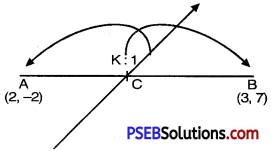
![]()
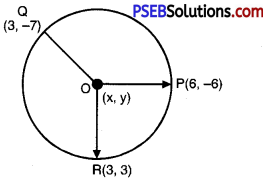
![]()
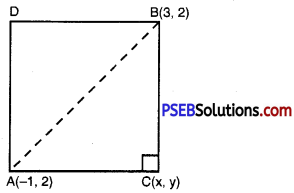
![]()
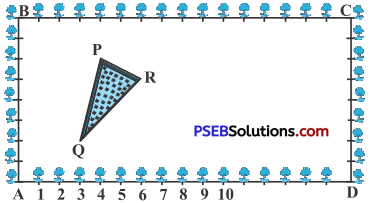
![]()
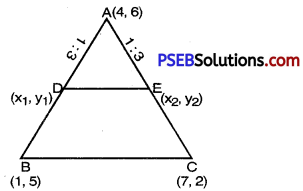
![]()
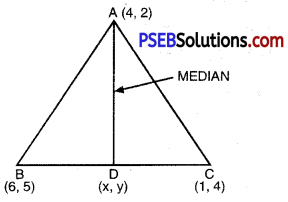
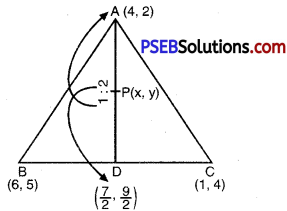
![]()
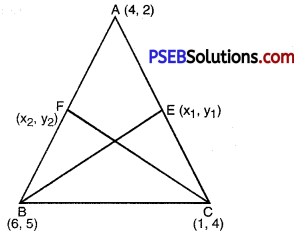
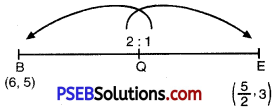

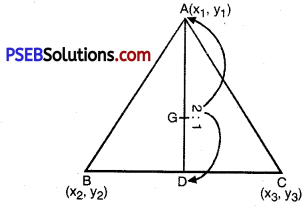
![]()
